DIY Slatted Wood Dresser
I’m super excited to share my latest thrifted furniture makeover with you! We completely transformed it into a DIY slatted wood dresser, (super similar to a fluted style dresser) and added a modern oak base to it. I also tried a new to me paint that I’ve heard a lot of raving reviews about.
Get more DIY dresser makeover ideas here!
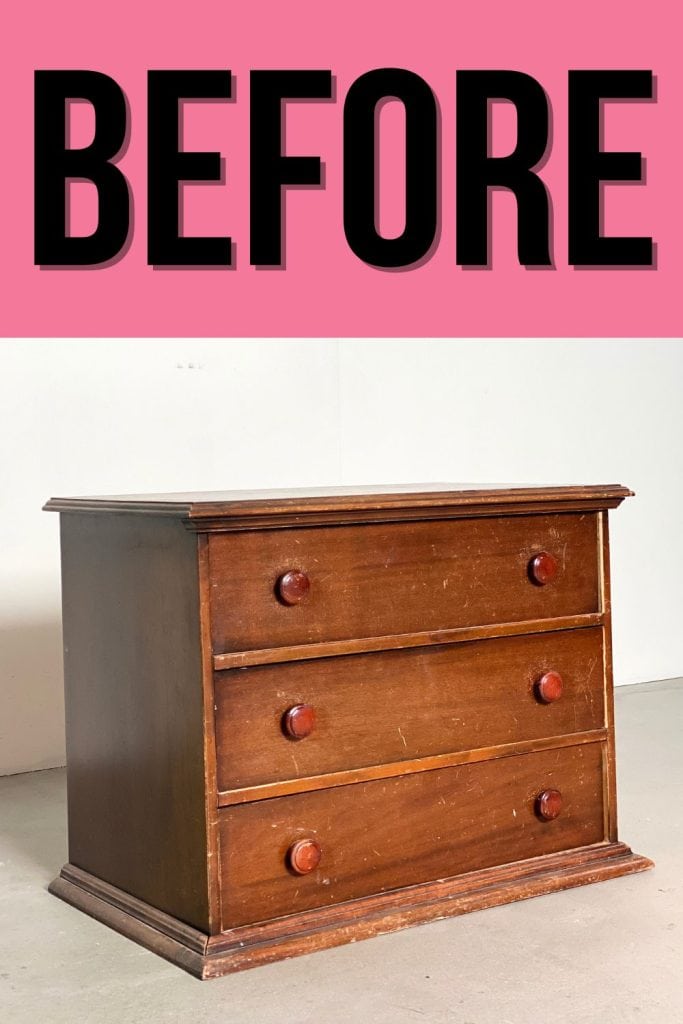
This is what the chest of drawers looked like after we picked it up from our local thrift store. It was $25, which is a steal in my area, missing its base, and it was pretty beat up.
But I loved the simplicity of it, and I was excited that it was a blank canvas to play around with.
Supplies Used for DIY slatted wood dresser makeover
As an Amazon Associate, I earn from qualifying purchases. I also may earn from other qualifying purchases with other companies or get free product to review and use. All opinions are my own.
- Kwik Wood
- Drawer Stops
- Krud Kutter
- Wood Filler
- SurfPrep Sander 3×4 vacuum compatible (Use code RAY10 to get 10% off your order)
- 220 Grit Sandpaper
- 400 Grit Sandpaper
- 150 Grit Sandpaper
- Shop Vac
- Tack Cloth
- Clear Shellac in a Spray Can
- Wooden Dowels 1/2″ and 5/8″
- Miter Saw
- Gorilla Glue
- Pin Nailer
- Melange One Paint
- Wagner FLEXiO 3500 Paint Sprayer
- Sprayer Paint Filters
- Respirator
- 1″x2″x8′ Oak Board
- Kreg Jig Pocket Hole Jig
- 1 1/4″ Pocket Hole Screws
- New Drawer Pulls
Check out this list of my 10 must have painting furniture supplies here.
Remove Paint From Dresser Top
Before I could really get started on this project, I had to undo what I did for another project that I did.
In that project I taped it off so I could compare different stain blocking primers, basically to show why I prime before painting.
I’ll link to that do I have to prime before using chalk paint video here for you! Or you can read all about how to stop stains from coming through paint here!
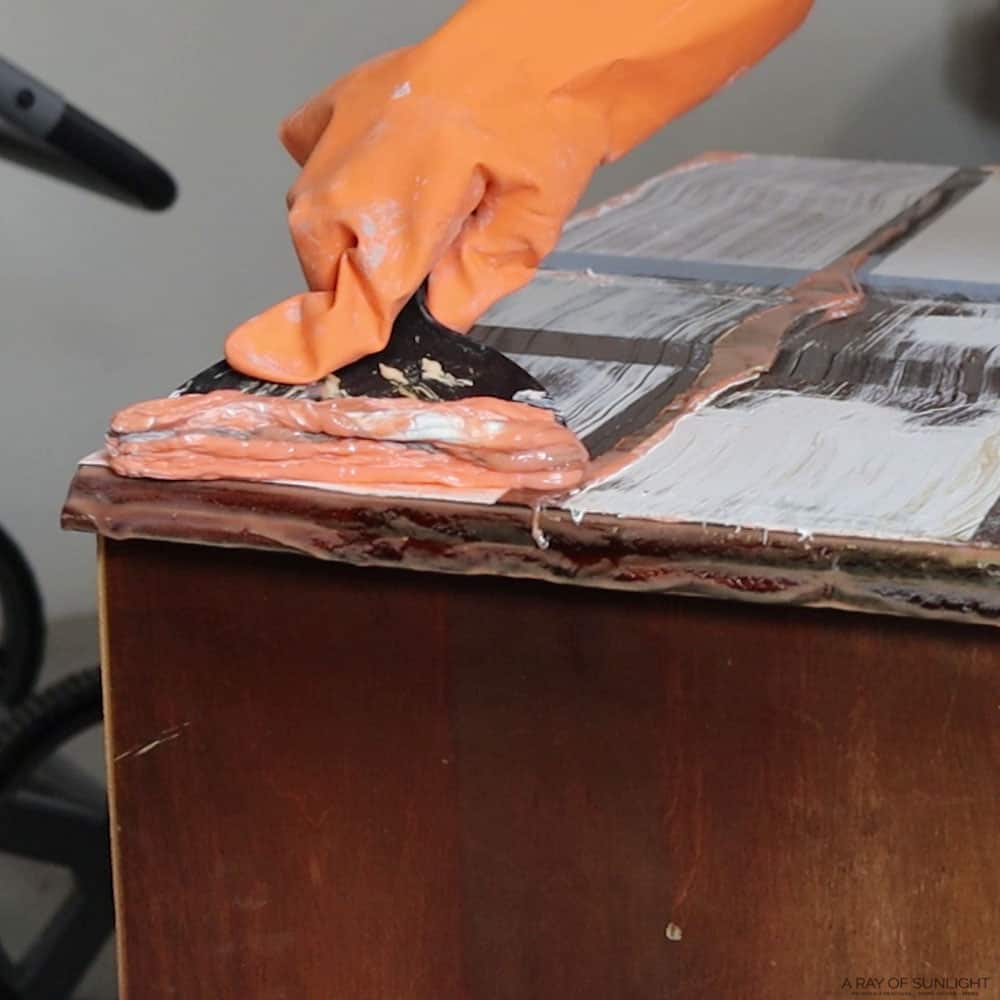
Anyway, I stripped that paint and primer off so I had a clean slate for this project, while I worked on the rest of the dresser. Learn more about how to strip paint from wood furniture here.
Make Repairs, Clean and Fill Hardware Holes
The dresser had a lot of spiders and webs inside of it… so my husband vacuumed it out for me. We also cleaned all the dirt and grime off with some Krud Kutter and a damp rag.
Learn more about how to clean furniture before painting here!
If you’re worried about germs, bacteria, and bad odors lurking inside your dresser, check out how to disinfect wood dresser here!
And then I replaced the missing drawer stoppers with new ones that I bought on eBay a long time ago.
And, I feel like I do this in about every single makeover, but I filled in the old hardware holes with my very favorite filler for filling hardware holes. Learn more about how to use KwikWood here!
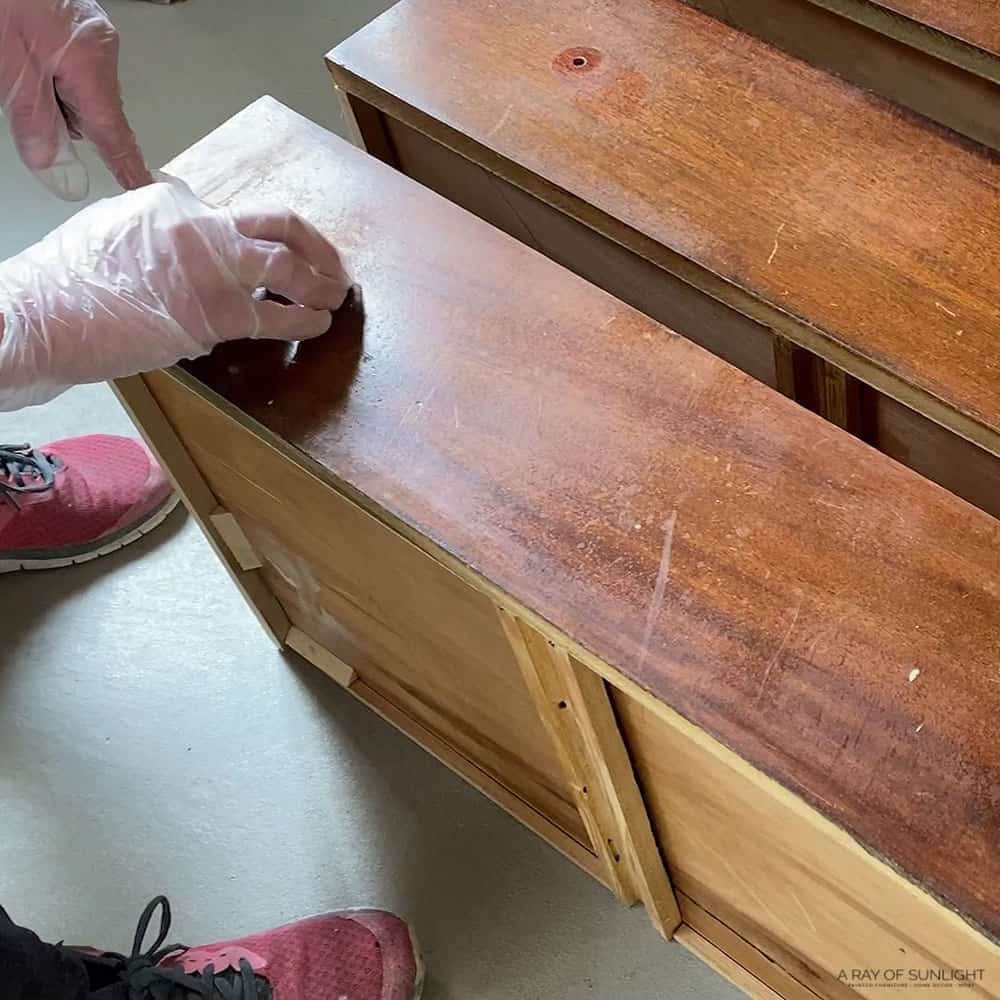
Add Wood to Make Slatted Drawers
Then things got really fun!
Buying the Wood
We went to Home Depot and bought a bunch of ½” and 5/8” square dowels. While we were at it, I made sure they were all straight, with no warping or twisting in the wood.
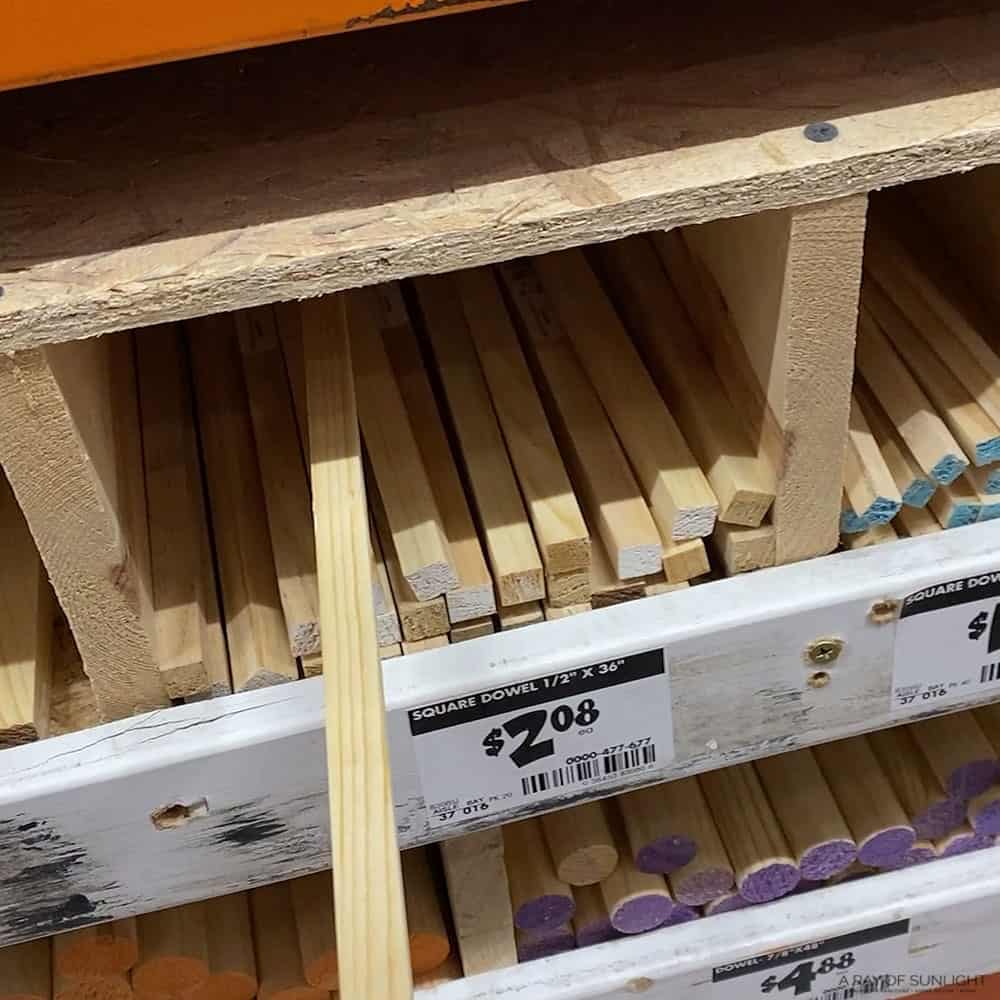
Cutting the Wood
When we got home, I measured the drawers and somehow managed to realize that I needed to take into account for the new hardware before I cut the wood.
So I put the new hardware on, and then I measured again.
And then I cut the wooden dowels with my miter saw. I clamped some wood down onto the saw to make sure I cut them all the same length, and I cut them in groups of 3.
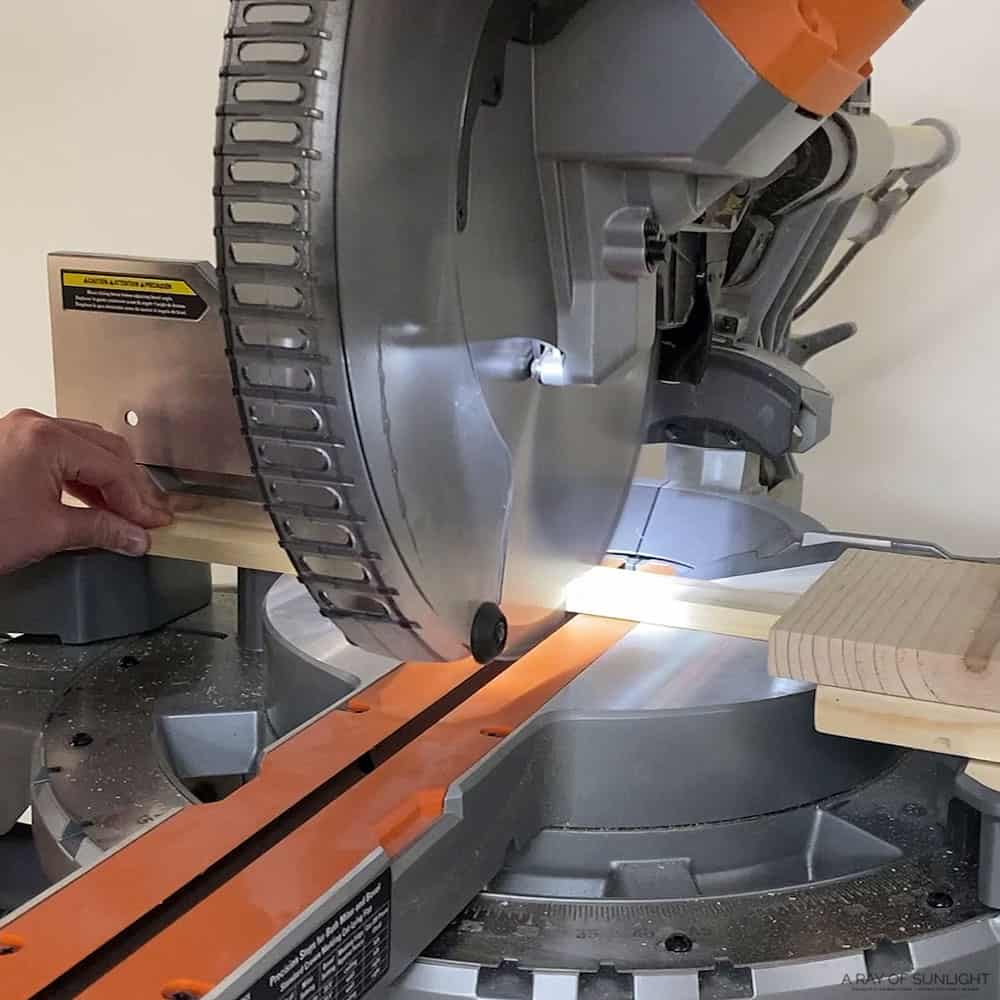
In total, I used 12 three-foot-long dowels for 3 drawers. And then I laid them out on the drawers to make sure I cut enough, and that they were all cut the right size haha.
And then before I attached them to the drawers, I removed the stickers and sanded each piece so they didn’t have any splinters on them. Read this post to learn about the best sandpaper for furniture!
Attaching the Wood
Then I started in the center of the drawer, attaching them with a pin nailer and some gorilla glue.
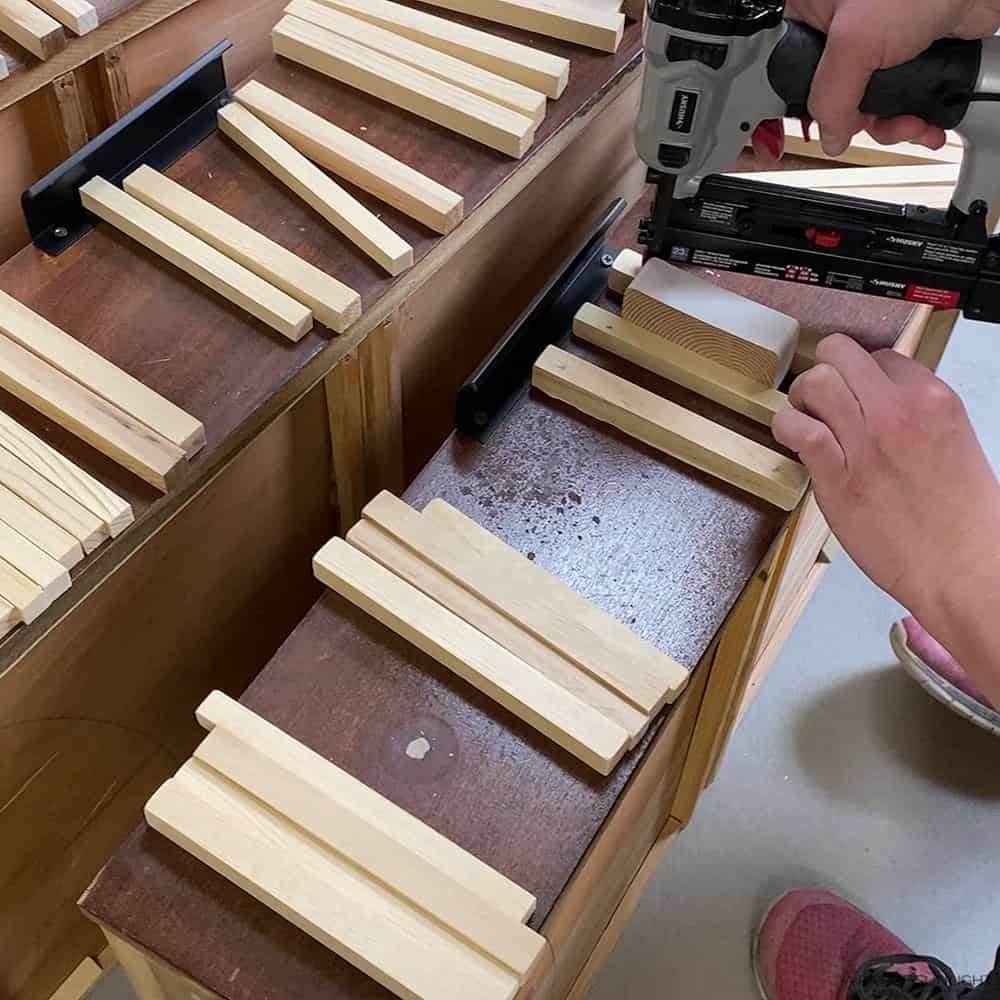
I went for a 1” gap between each dowel, and alternated between the ½” and the 5/8” dowels.
The most frustrating part of the whole process for me was that the pin nailer kept getting jammed, so I had to keep fixing it. But I didn’t want to use my regular nail gun for fear that it would split the dowels.
And I needed something to keep the dowels in place while the glue dried because they kept moving around with a space in between each of them.
The whole process of measuring, cutting, sanding, and attaching took about 3 hours for the 3 drawers. And I enjoyed every part of it… except for the sanding and the pin nailer jamming. haha
At the very end, I gave up on using the pin nailer and I just clamped the last pieces on. Check out these end tables with wood slats makeover to see how we created a similar look on end tables.
During that project, the pin nailer acted up again, so I used painter’s tape to hold the dowels in place while the glue dried…and it worked great!
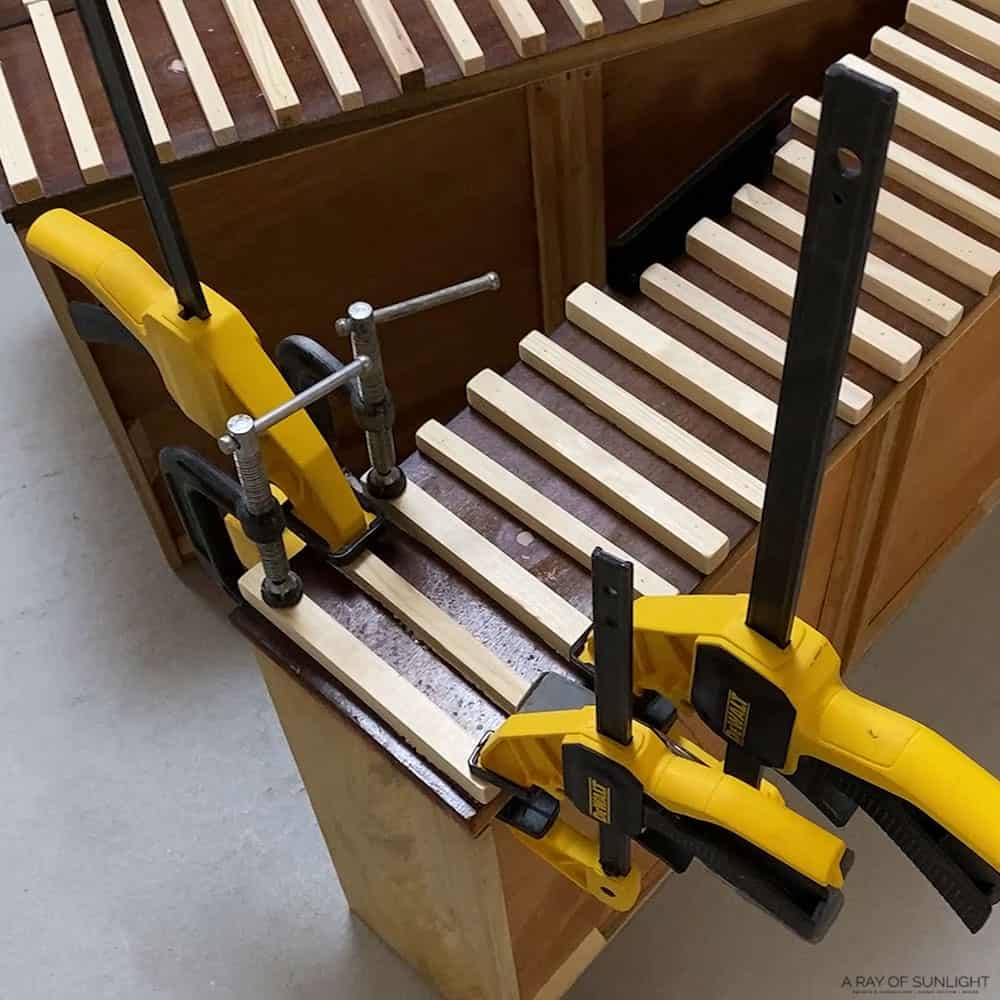
And then I let it all dry overnight.
Fill Holes and Sand
The next day I sanded the top and sides of the dresser… and realized that I needed to sand the filled-in holes… so I sanded those down smooth with some 150-grit sandpaper.
And then I put some wood filler over the pin holes. Then waited for the wood filler to dry. Here’s our list of the best wood fillers for furniture.
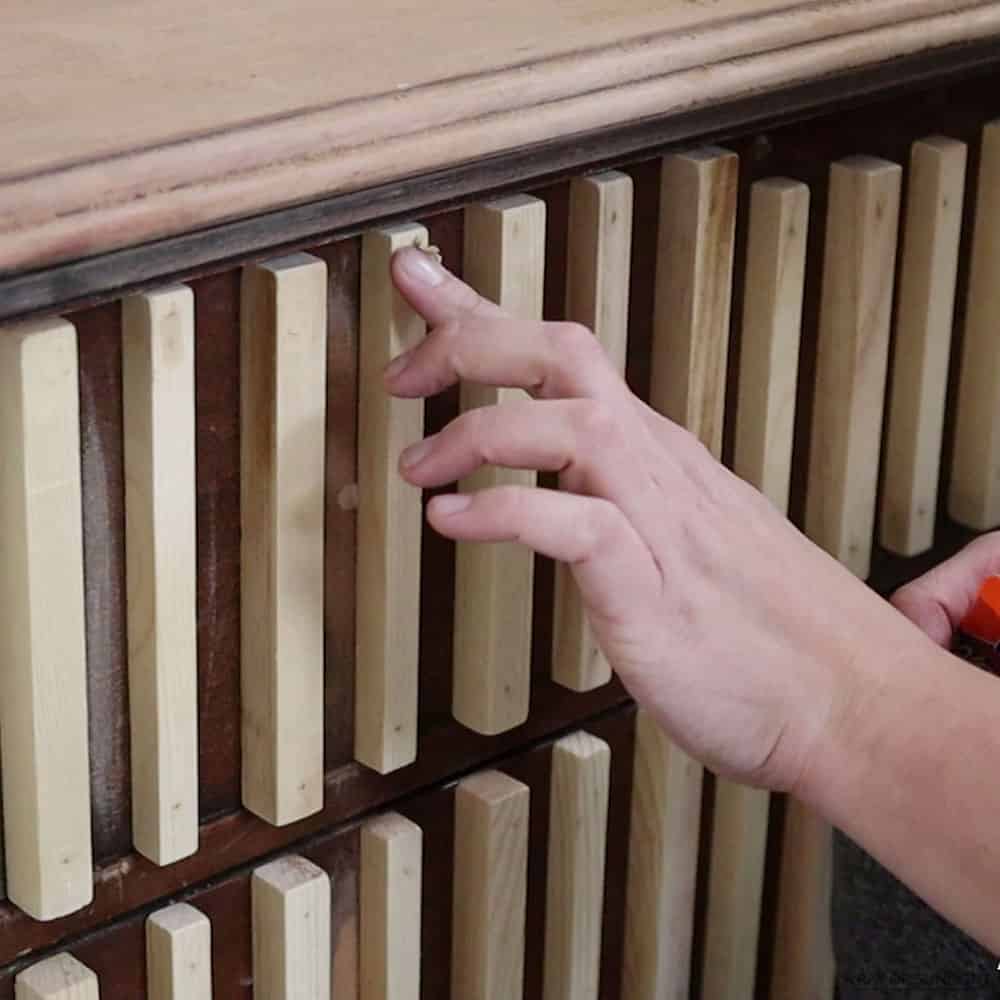
And then I sanded that wood filler down with 220 grit sandpaper. Here’s our list of the best sanders for furniture. If sanding is confusing to you, here are all of our tips on sanding before painting furniture.
Oh, and then if that wasn’t enough, I also sanded the top of all of the dowels to make sure they were level with the drawer and to make them a little bit more smooth.
Finally, I was able to clean up all of the dust and move on to the next step.
Prime Dresser
And that next step was to prime the dresser for paint. I used clear shellac in a spray can. If you’ve seen any of my previous stuff… I bet you’ve seen this stuff. Haha
It’s my favorite thing to use to prevent bleedthrough… and I’ve found that it makes paint stick to even really slick surfaces too.
I know, it’s weird. I get so many comments about shellac and if it really makes paint stick. And yes, paints of all kinds really do stick very very well to it! It still blows my mind.
Confused about what primer is best for your project? Here’s our list of the best primers for painting furniture (and how to choose the right one).
Anyway, I sprayed two coats of clear shellac on the dresser. And then I let it dry overnight.
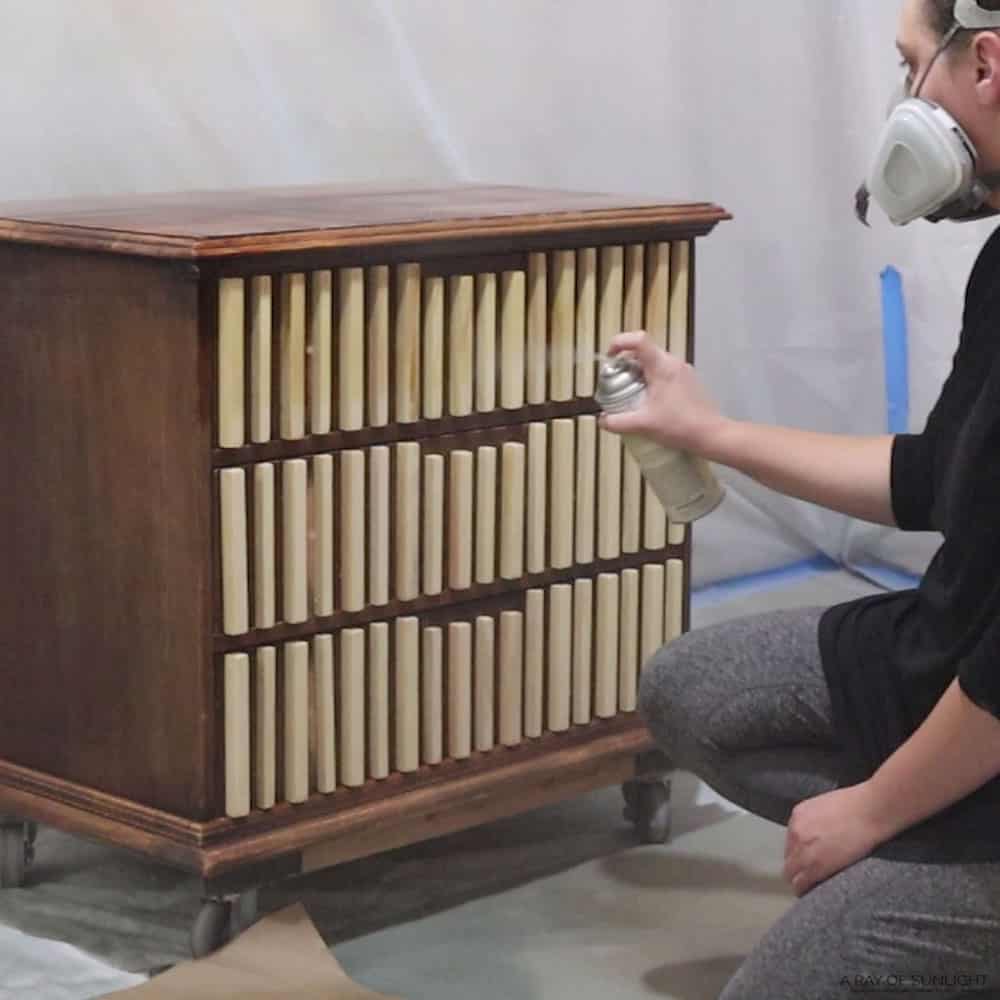
Painting A Dresser
So for this dresser, I used Melange’s single-step paint called ONE in the color Jett Black. I’ll talk a little bit more about it later.
Anyway, I chose to spray it this time, so I poured it into my Wagner FLEXiO 3000 paint sprayer (the newest model is now called the FLEXiO 3500). This paint sprayer is an entry-level paint sprayer that I’ve seen a lot of other painters using, so I tried it out a few months ago.
I liked the detailed finish nozzle part of it, and it seems to be similar to but better than the cheaper Wagner sprayer I first sprayed with.
But I chose to use this sprayer this time because I want to keep testing it so I can help you guys with your paint sprayer questions more. Haha I’m so glad that I did!
*Update: I have since tried several paint sprayers and this one ranks as one of the best in my opinion. Read my full review of the best HVLP paint sprayers for furniture here!
Check out this post to learn more about how to use the FLEXiO 3000 paint sprayer.
Thinning Paint
When I thinned out the paint, I started by just eyeballing around 20% water-to-paint ratio.
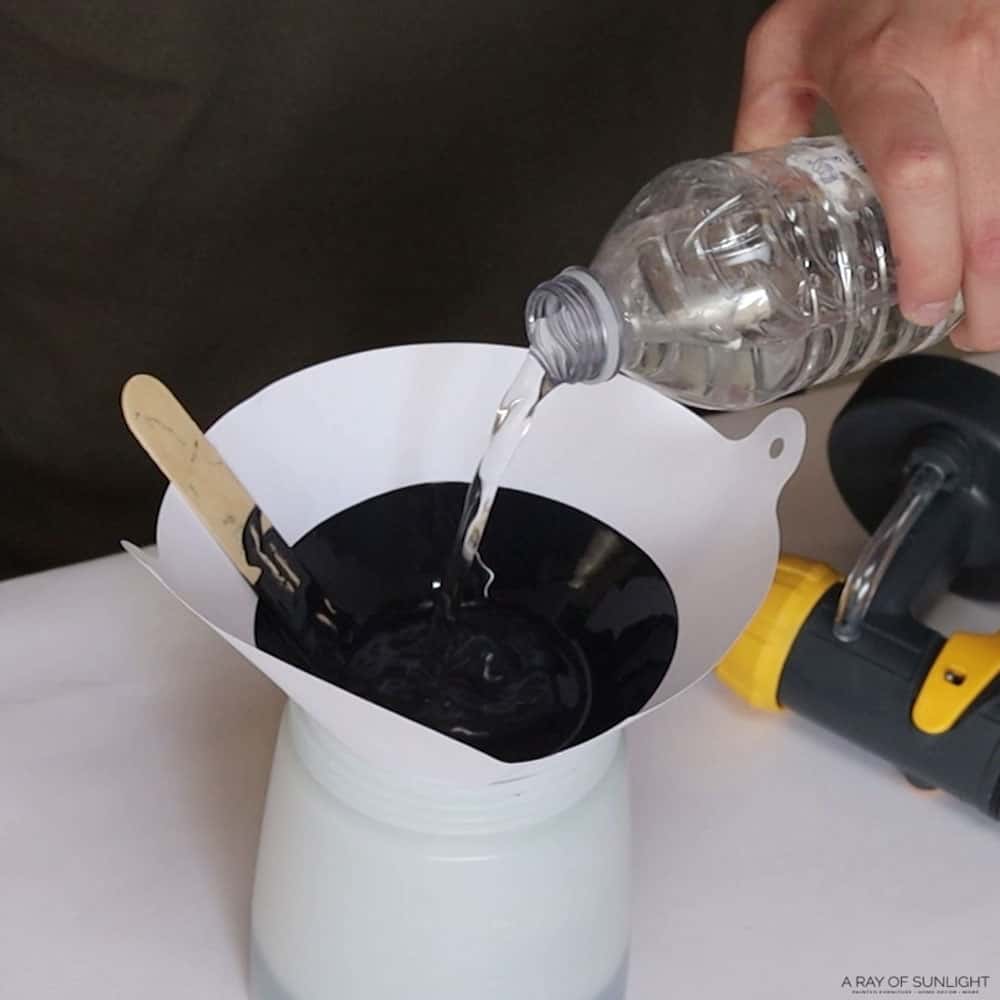
And then I used the viscosity cup that came with my other Wagner paint sprayer to see how close it was to how that sprayer’s owner’s manual says to thin out the paint.
(The FLEXiO 3000 doesn’t give much info on how much to thin out paint with the detail nozzle.)
Learn more about how to thin paint for Wagner FLEXiO sprayer here.
With the other Wagner, it usually needed to run out of the viscosity cup at around 40 seconds. It was still SO much thicker than that with only 10% water.
So I kept mixing in water until I got it to run out of the viscosity cup at 43 seconds. I think it ended up being around 40% water ratio! So 6oz of water to 15 oz of paint! Read more about how to thin paint for a Wagner sprayer here!
Oh, before I started spraying the paint, I taped the dresser drawers with some plastic to prevent overspray when painting furniture.
Testing the Paint Sprayer Settings
Then I plugged in the sprayer, set the setting to 3, and tightened the dial behind the trigger all the way into the trigger, and then I turned it 20 strokes to loosen it.
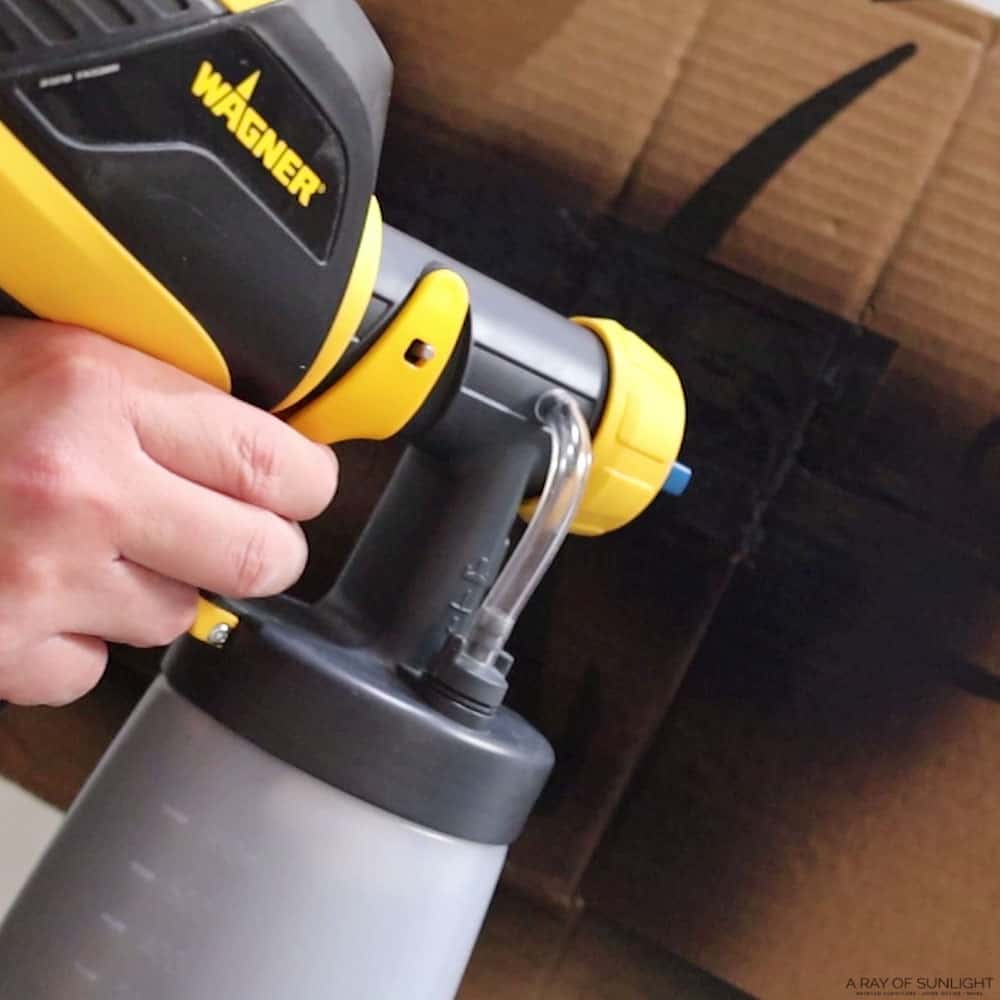
After I tested it on some cardboard, I wanted more paint to come out, so I tightened it back up 5 strokes (making it a total of 15 strokes away from being completely tightened) and tested the spray again. I was super happy with those settings, so I moved on to spraying!
Spraying Melange Paint
This is the first time I have used Melange, but I’ve heard SO MUCH about it. So I had to try it. Especially after I heard my girl Sarah at Sitting Pretty Home Décor rave about Melange.
This is their all-in-one formula that has a satin sheen. But I’ve heard that it levels so well, even when brushing. And they have an absolutely amazing color pallet to choose from.
Read through my detailed Melange One Paint Review to learn more.
Check out this list of the best paints for furniture.
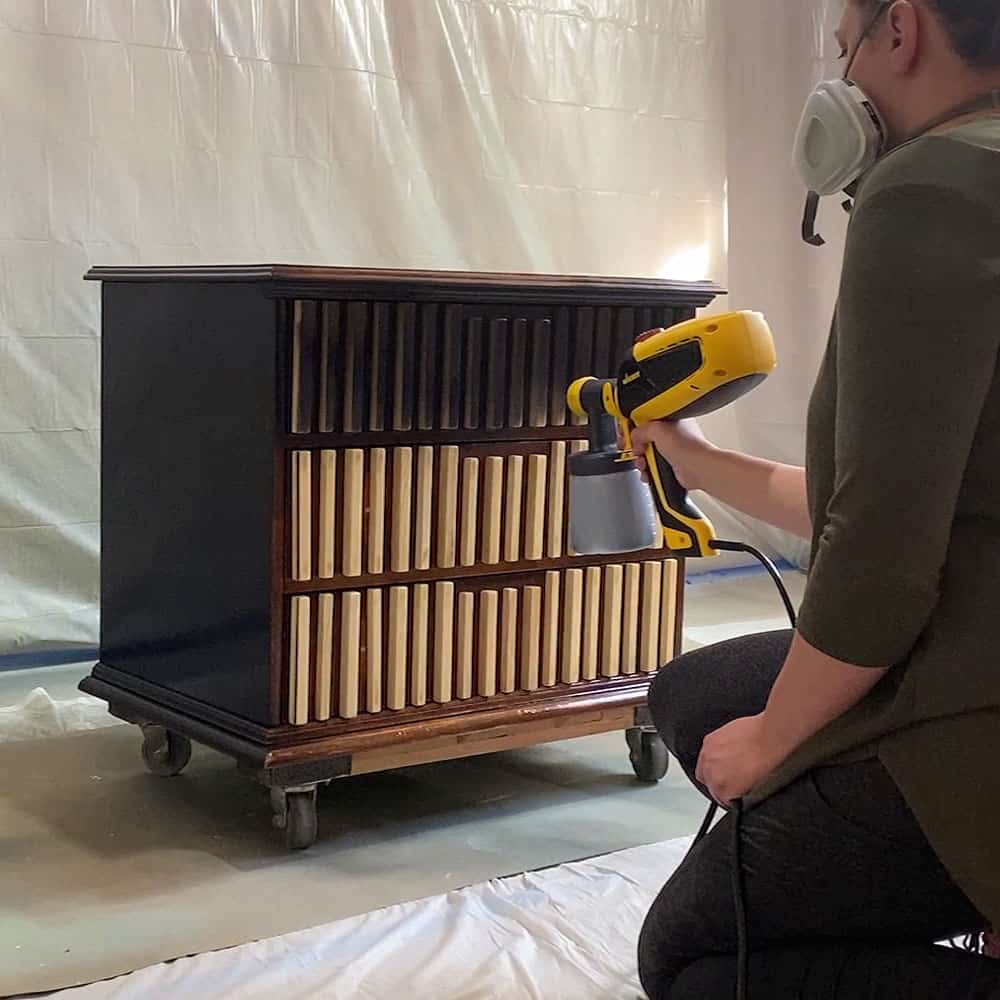
Anyway, after the 1st coat, I let it dry for about an hour. In between coats, I left the sprayer right there, not doing anything to it. Before I sprayed the next time, I used my nail to pick off the dried paint from the tip of the sprayer.
Learn everything you need to know about painting furniture with a sprayer here.
For the second coat, I sprayed the drawers again, getting the sides of the dowels better, and opened up the drawers so I could spray the sides and tops of the drawers too.
Then I let it dry for about 2 hours.
When I came back, the dowels were super rough feeling, so I sanded them smooth with 400 grit sandpaper, cleaned off the dust, and painted the 3rd and last coat of paint.
I was so impressed with how this paint sprayed and leveled out. There is absolutely no texture or splatters of any kind in the finish. It looks SO GOOD!
**UPDATE: I have now used Melange ONE paint several times and I think I love it even more than the first time I used it. Check out this how to fix damaged wood furniture post where I painted this dark green dresser with Melange ONE here!
Make and Attach New Dresser Base
A few days later, we flipped over the dresser and built a new base for it. I cut a 1” x 2” x 8-foot oak board at a 5-degree angle to make the legs.
And then I cut some more of that same board at the same angle for the front of the base. And then some more straight cuts for the 2 sides of the base.
Then we put the base together and attached it to the bottom of the dresser with some Kreg Jig pocket holes and screws.
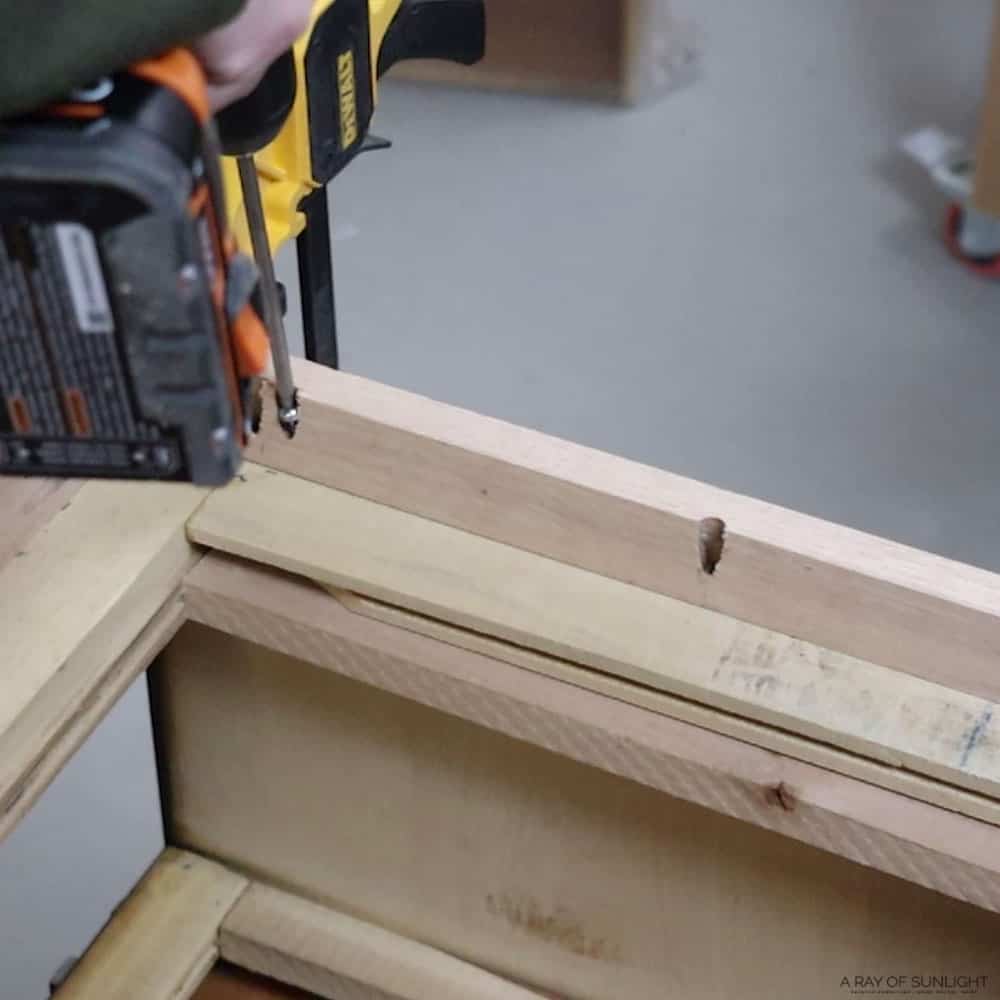
Maybe one day I’ll share more about building a base for a dresser. Let me know if that’s something you want to see!
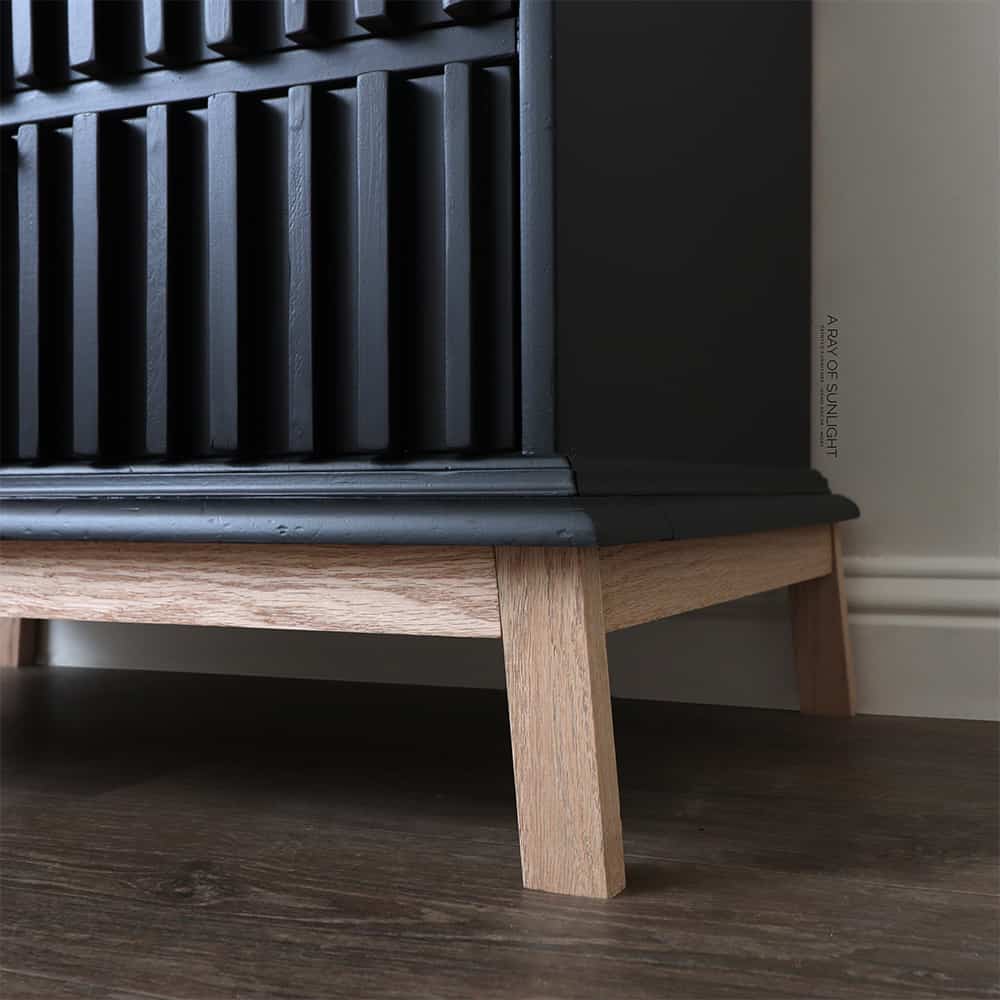
And here’s what it looks like now. I can’t wait for the chance to use this paint again! It looks SO SO GOOD! It’s very durable as is without any topcoat!
I’ve tried scratching at it, and it’s not going anywhere! I LOVE the satin finish too instead of the matte finish that most all-in-one paints seem to have.
Watch the video of this makeover here or scroll down to see the final results!
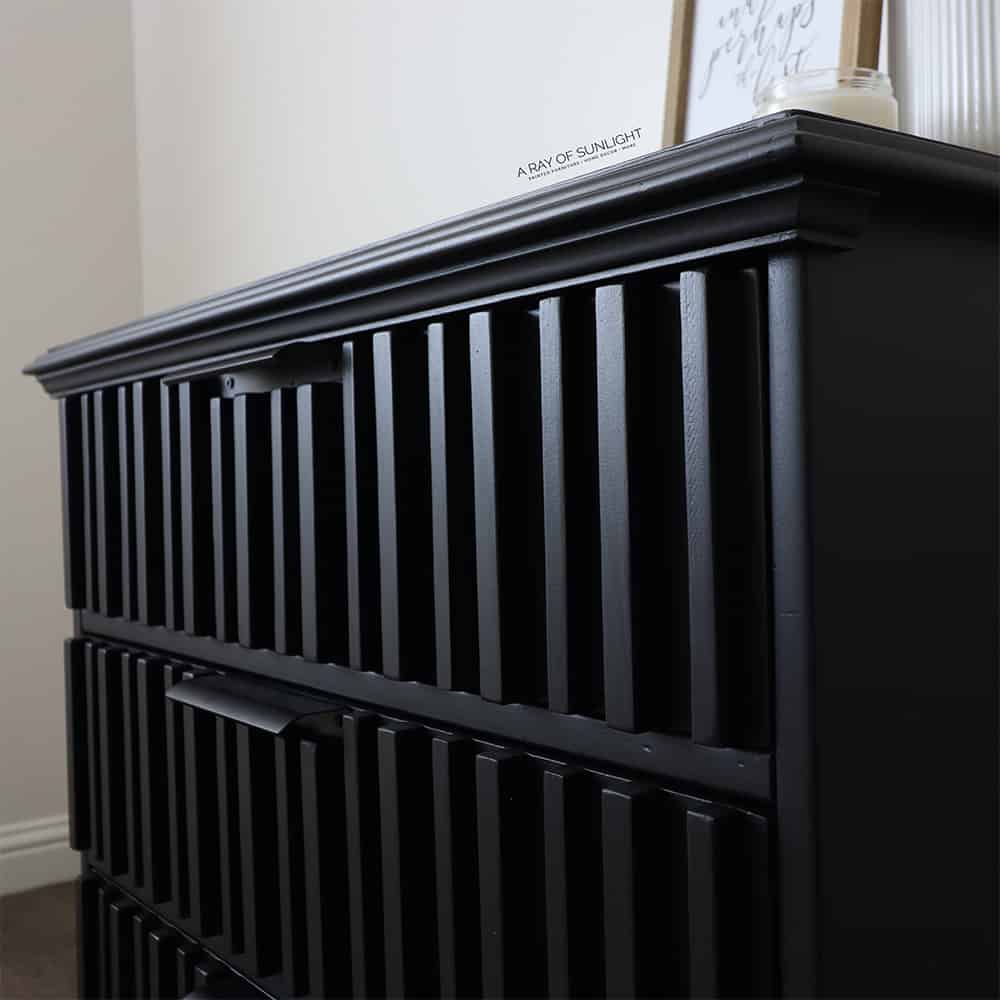
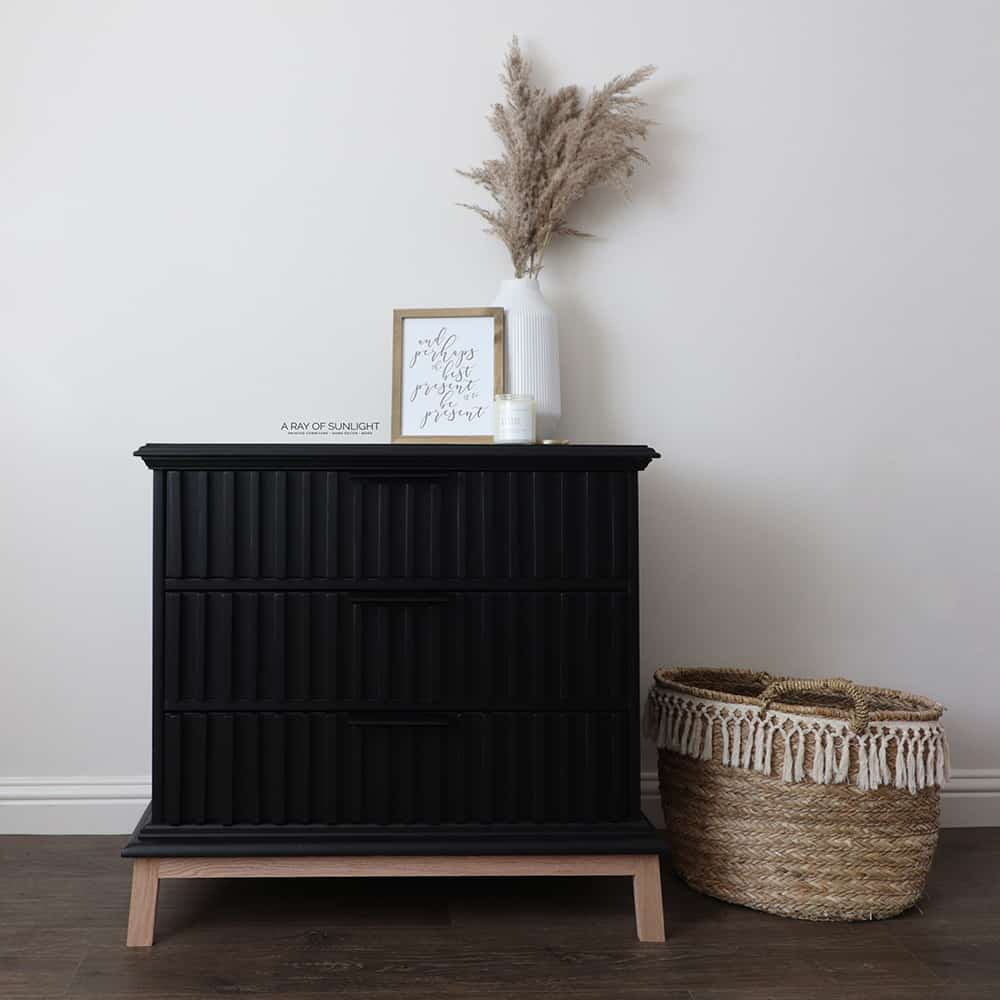
More Before And After Makeovers
Click any of these “before” photos below to view the “after” of that makeover.
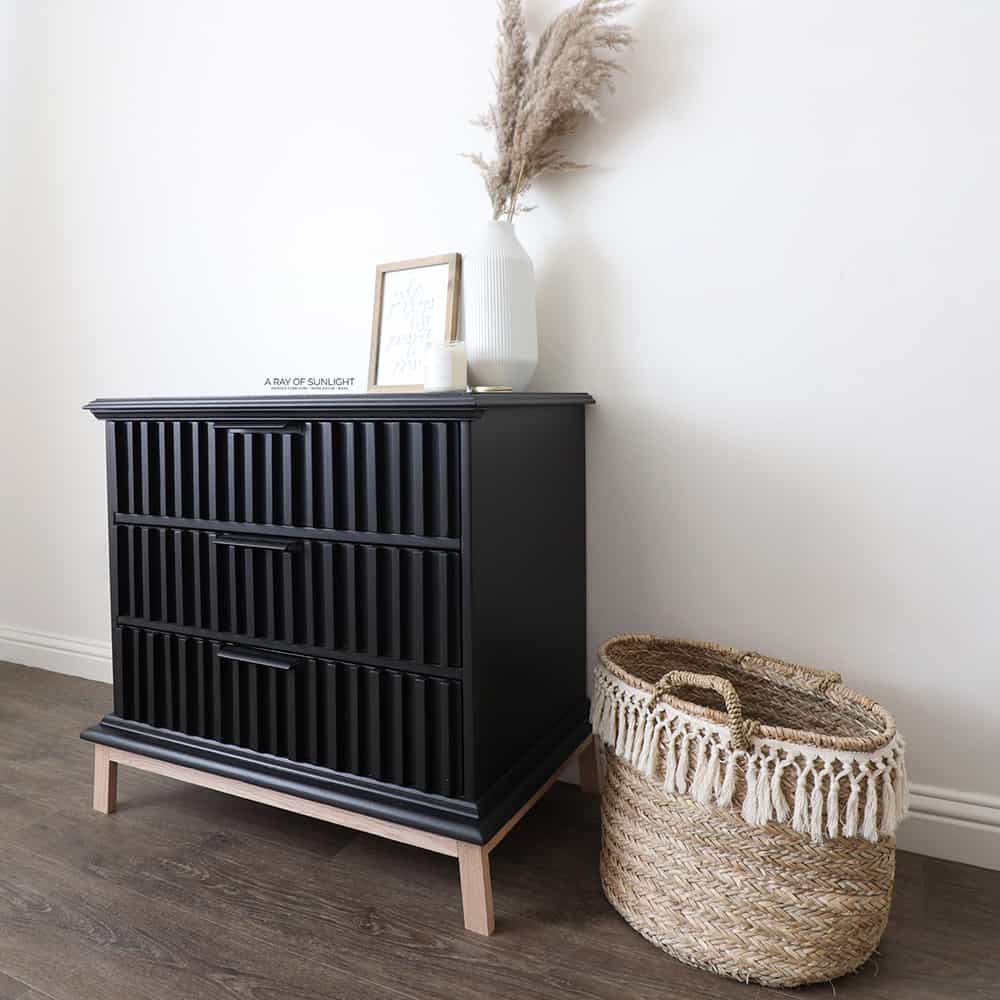
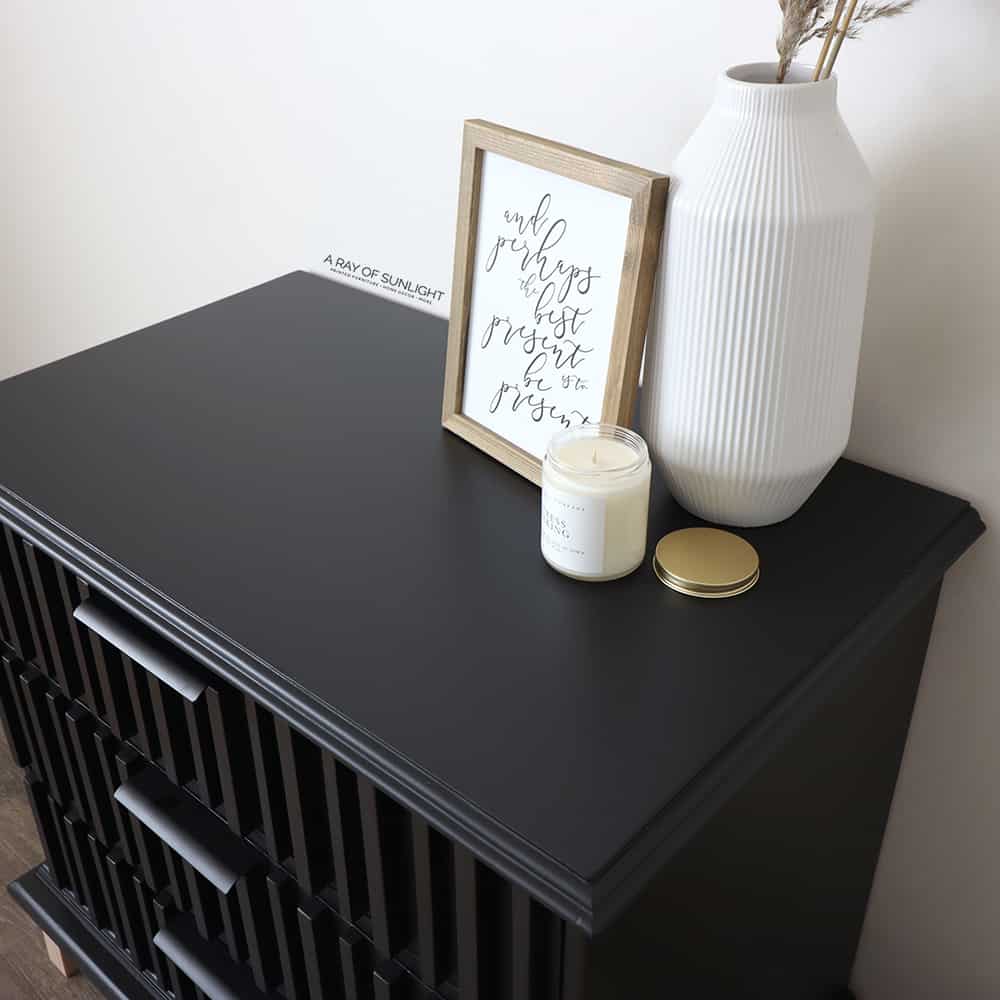
I think the slatted wood is so much fun! I’m not sure if I’ll do it this exact way again, and yeah, it’s probably not the most profitable thing to be doing with my time… but these extra things bring me so much joy.
And the wood base. Well, I love the look! I wish that I could find some 2”x2” oak wood for the legs. When I do, I’ll probably be making another base for another piece of furniture.
Anyway, what do you think of this makeover?? Get more painted dresser ideas here.
More Wooden Furniture Makeovers
- DIY Fluted Dresser
- DIY Mid Century Modern Slatted Wood Cabinet Upcycle
- Painting Furniture Grey
- Painting a Bed Frame Black
- DIY Farmhouse Dresser in Black
Follow us on YouTube to get more tips for painting furniture.
Or share your project with us on our Facebook Group and be part of our community. See you there!

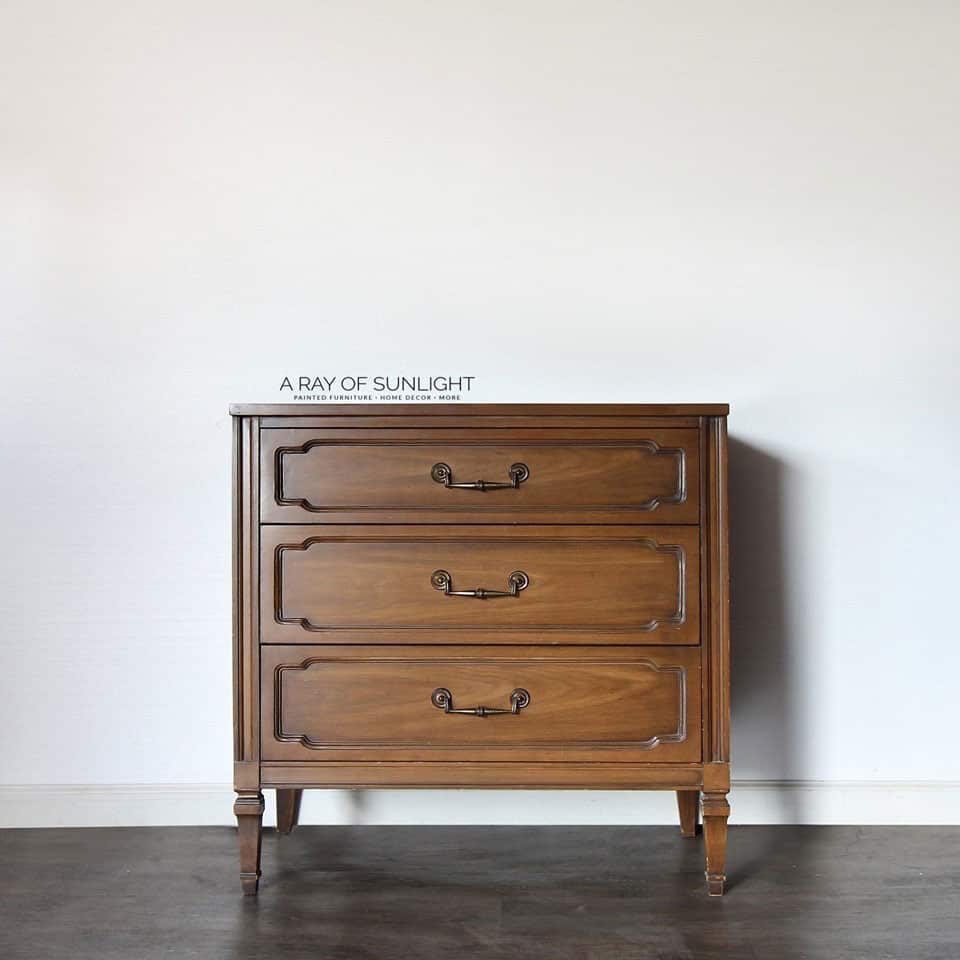
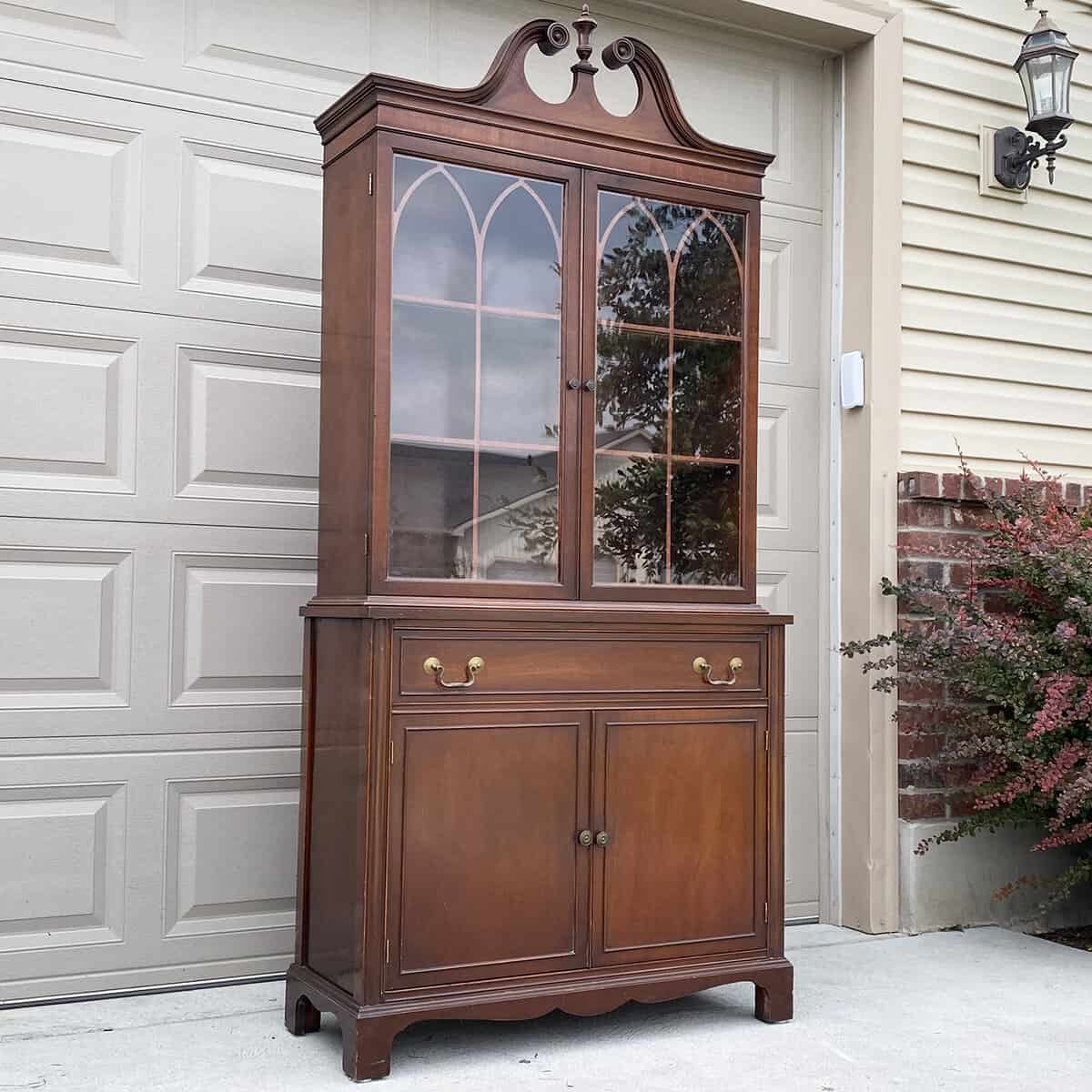
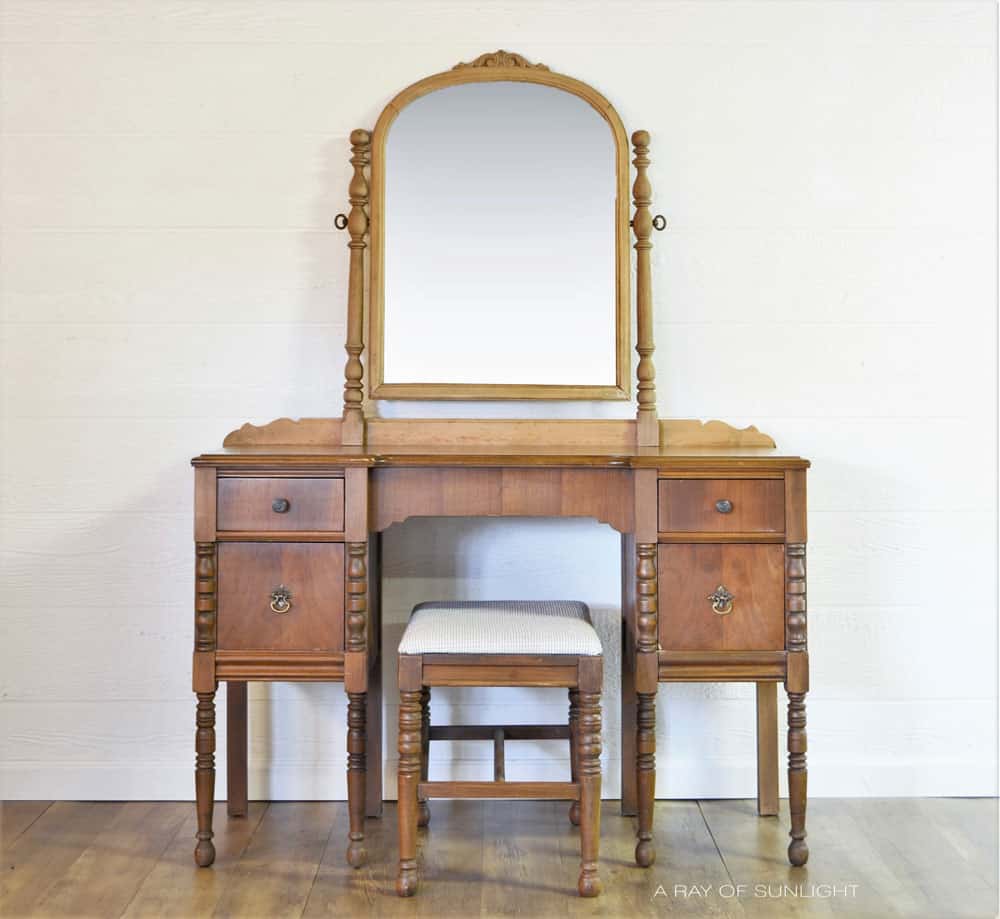
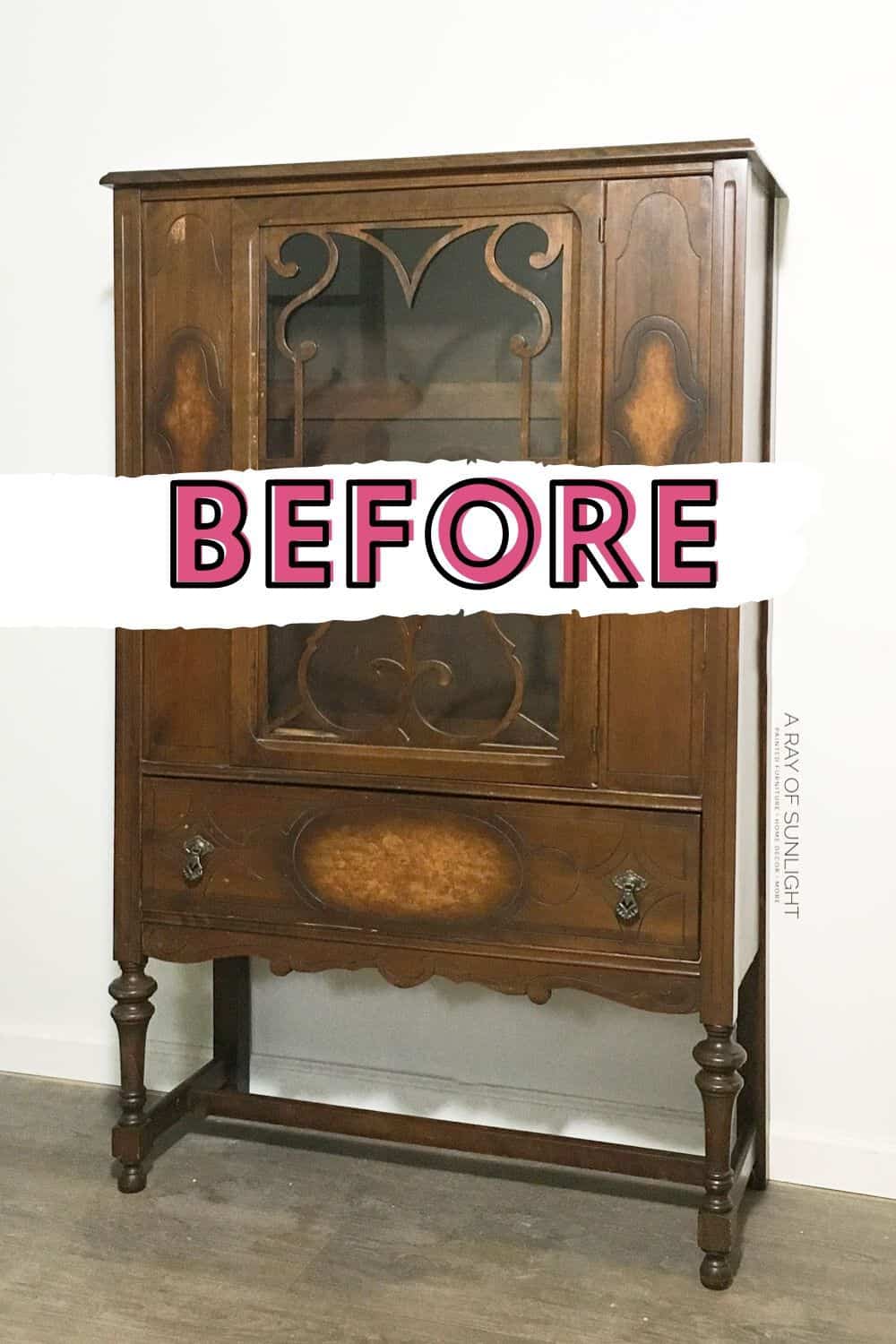
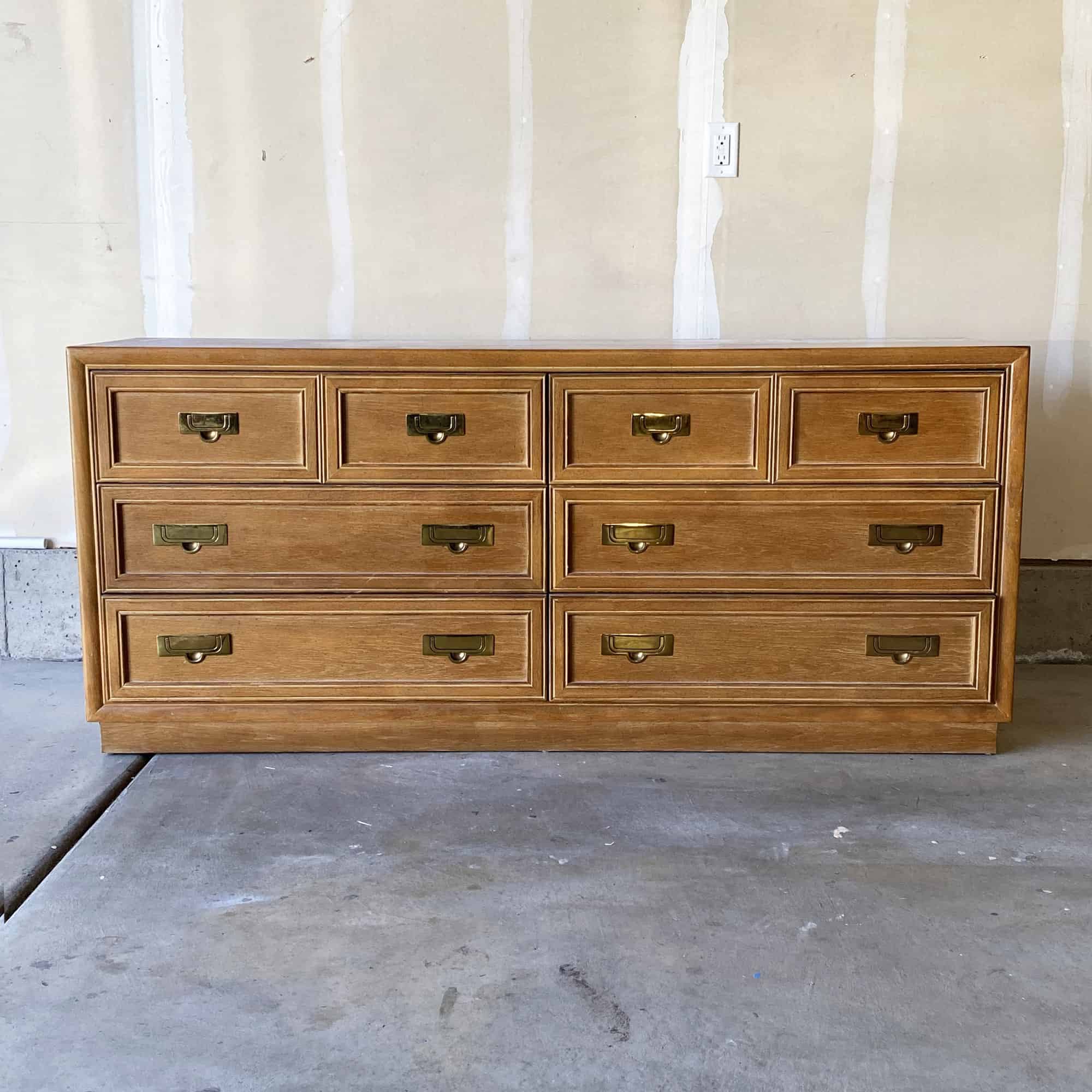
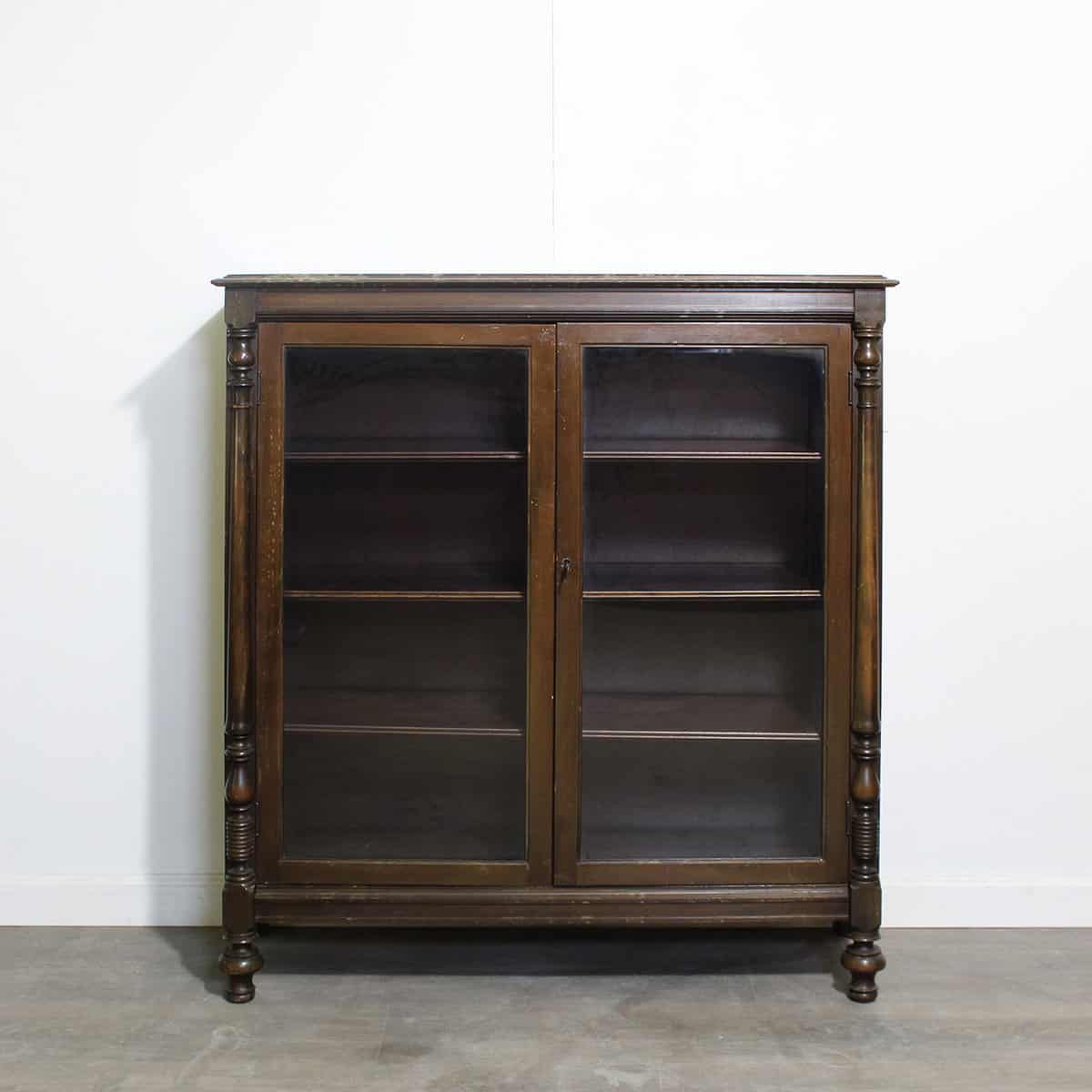
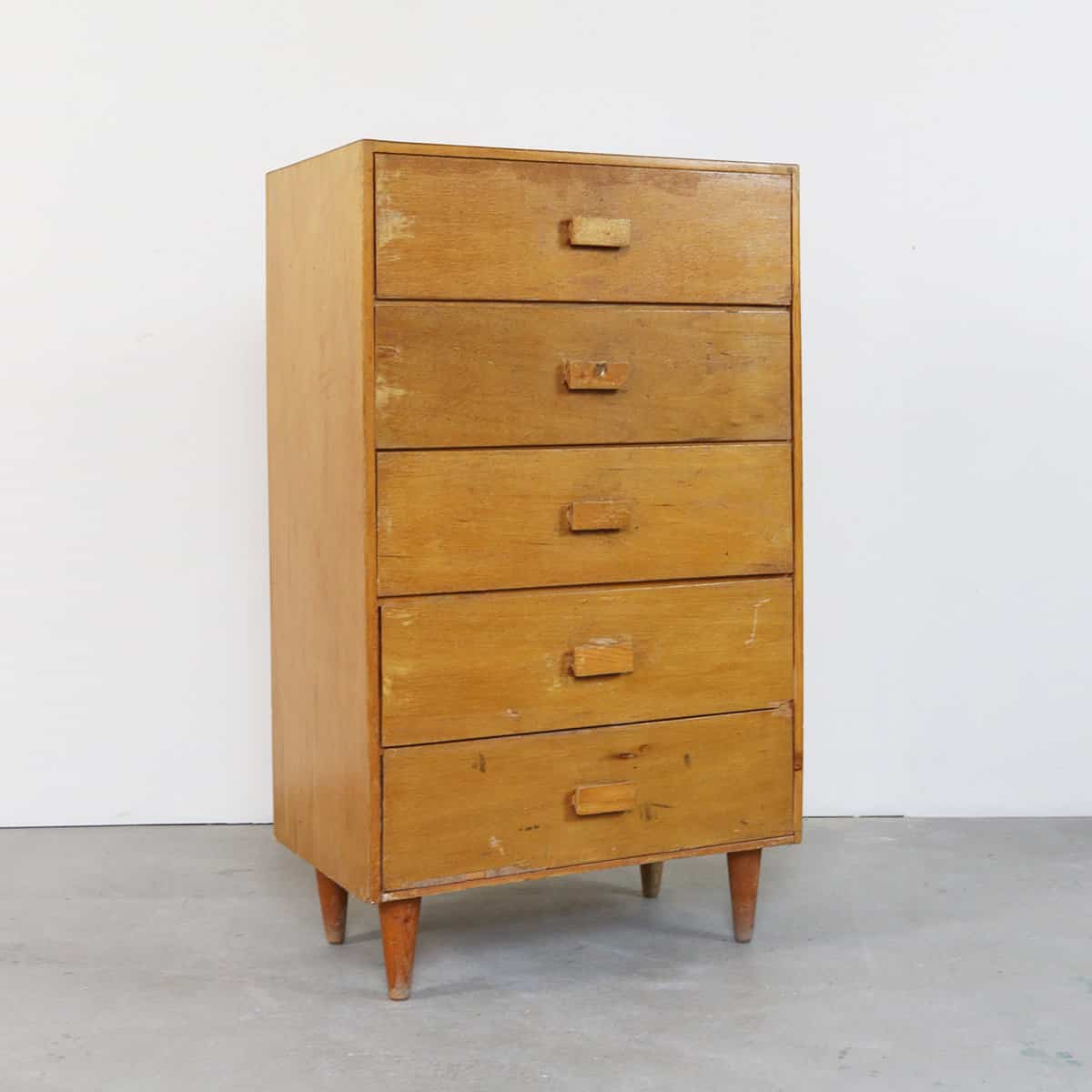
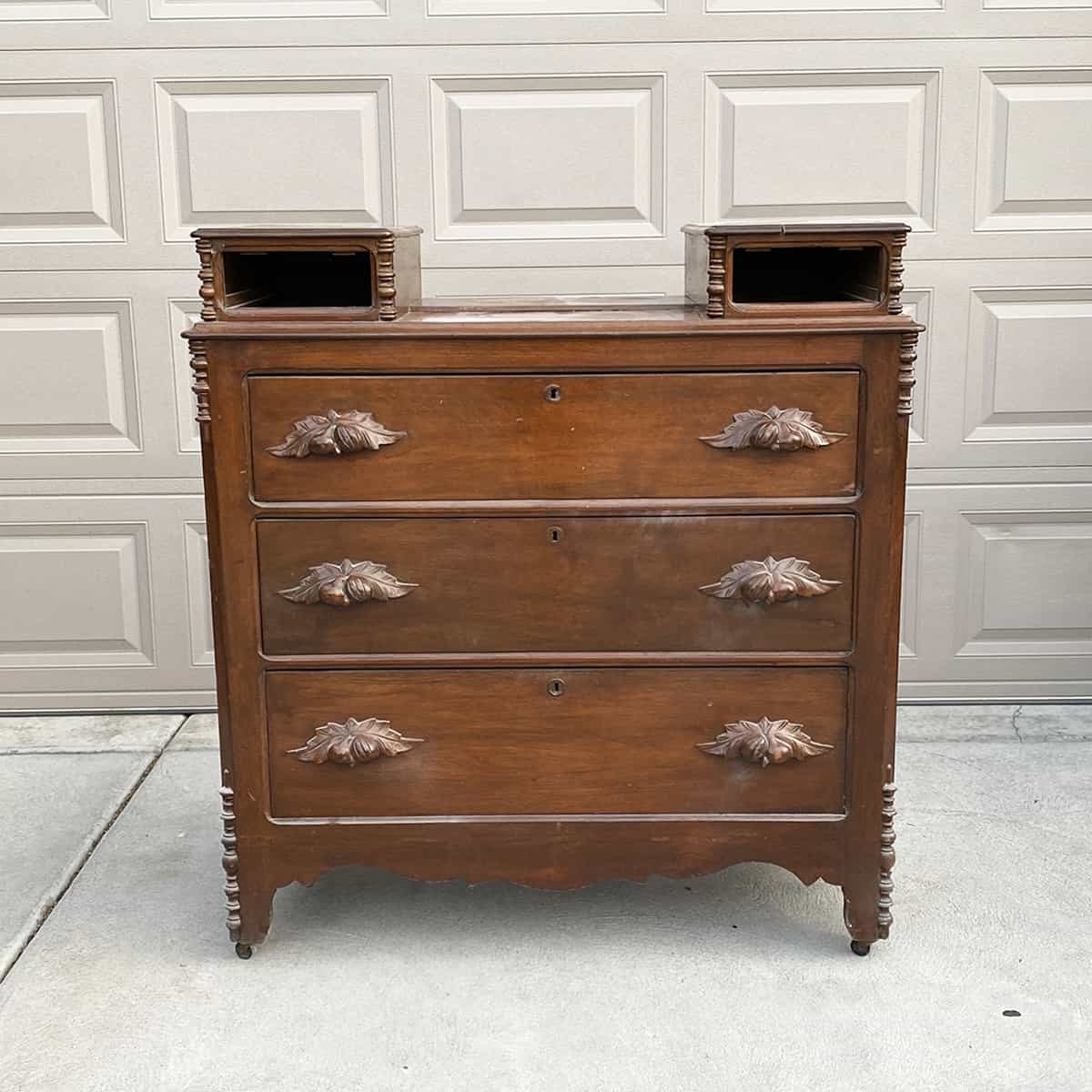
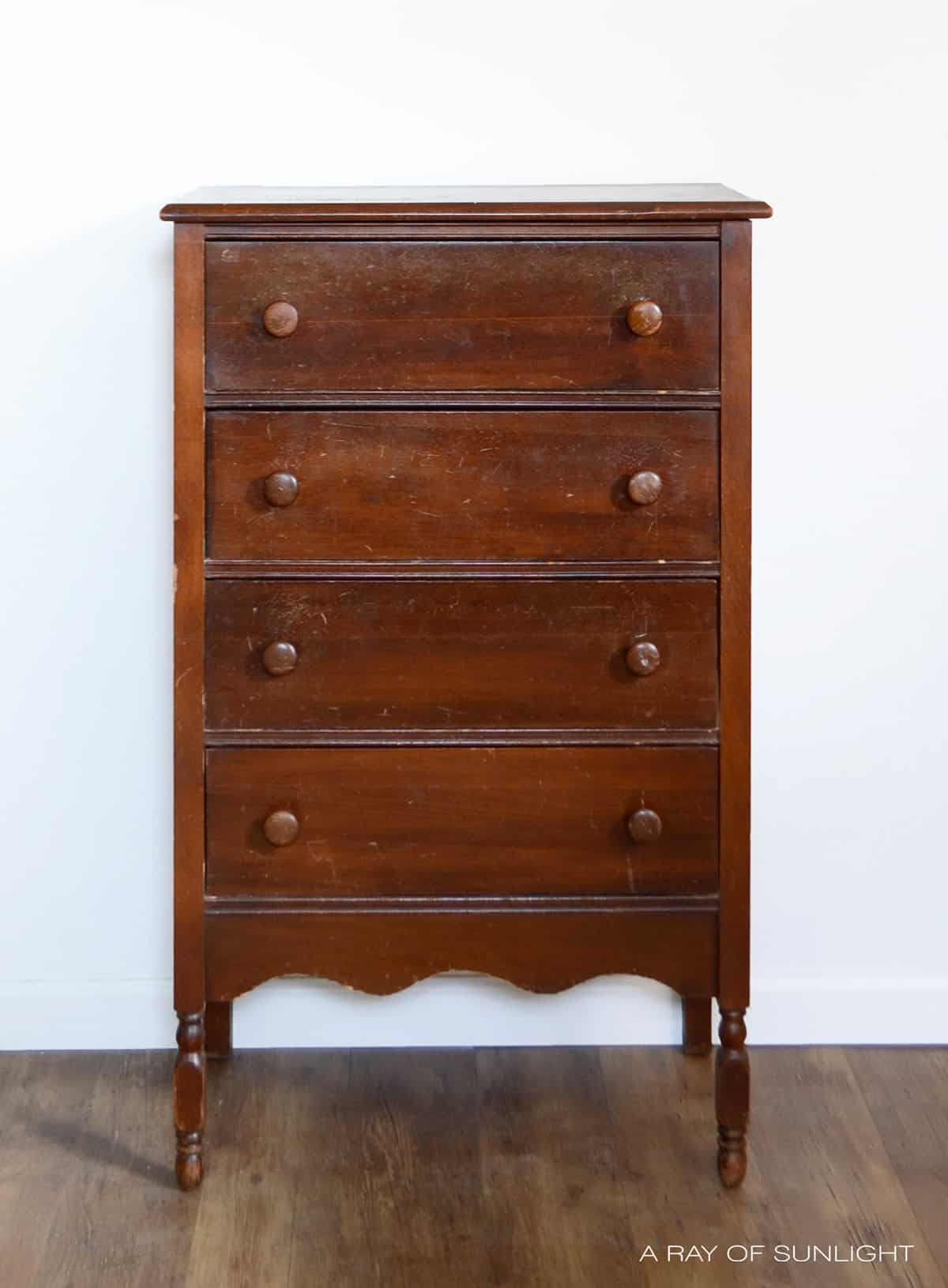
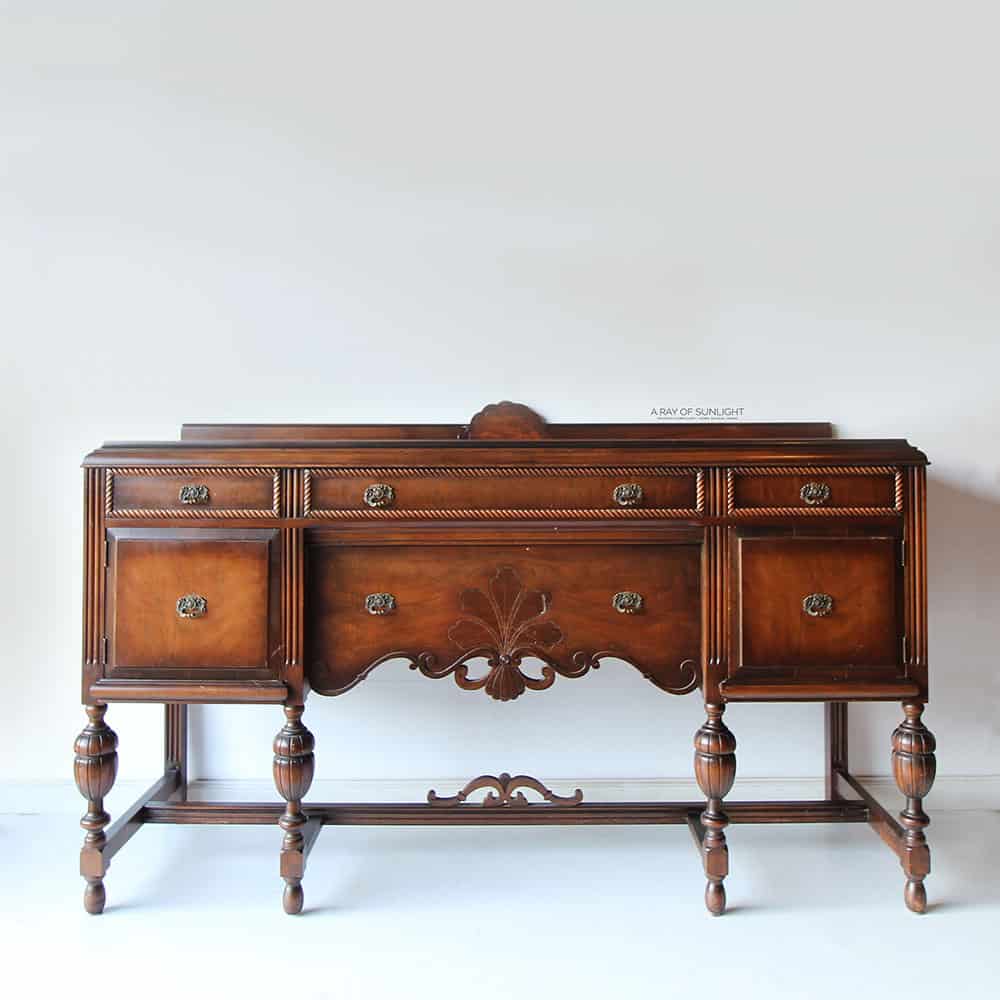
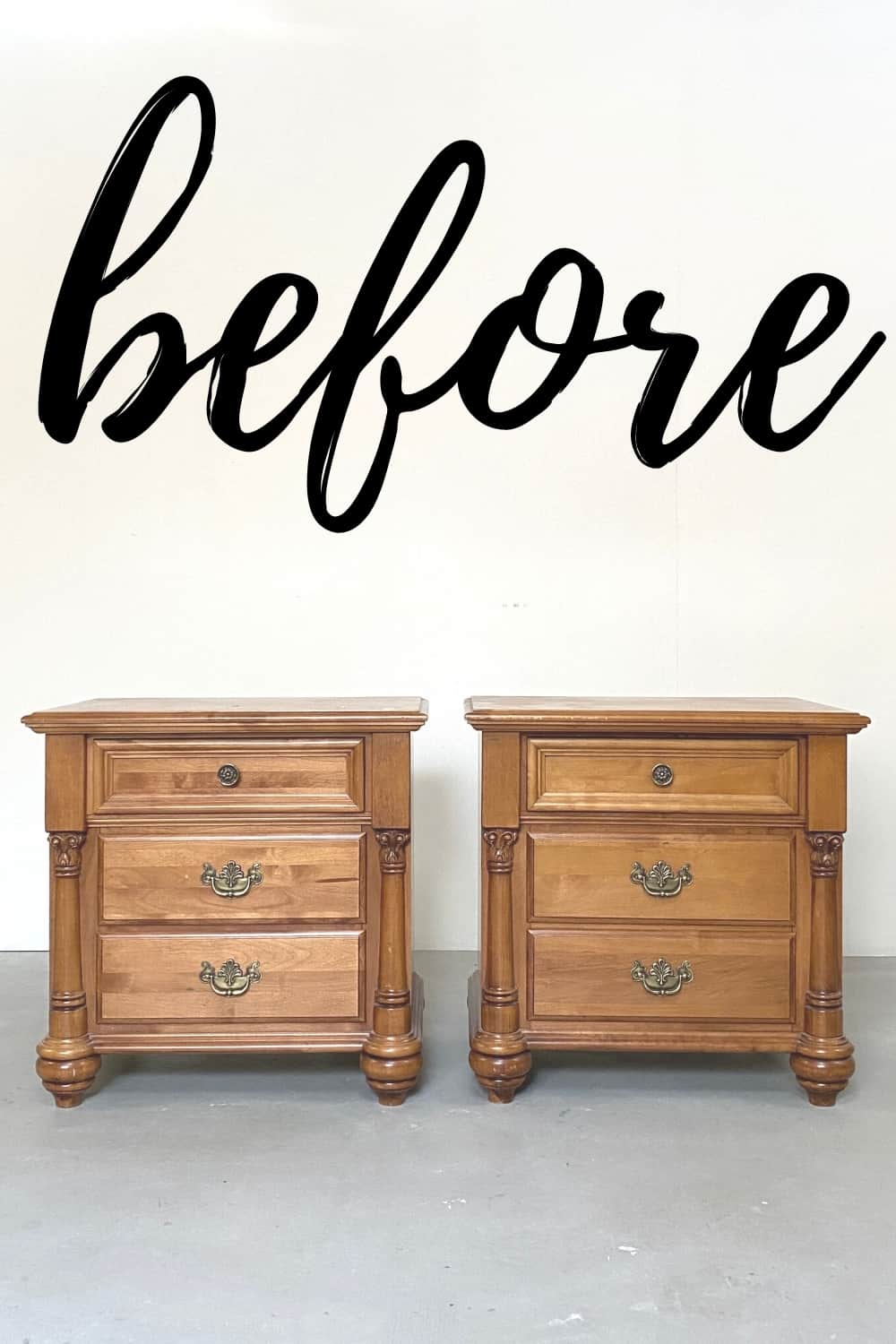
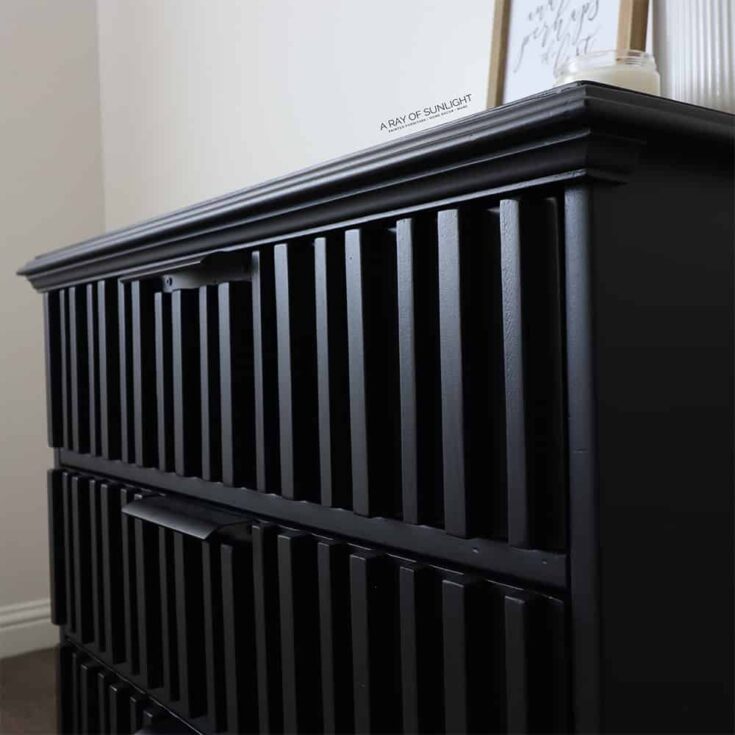



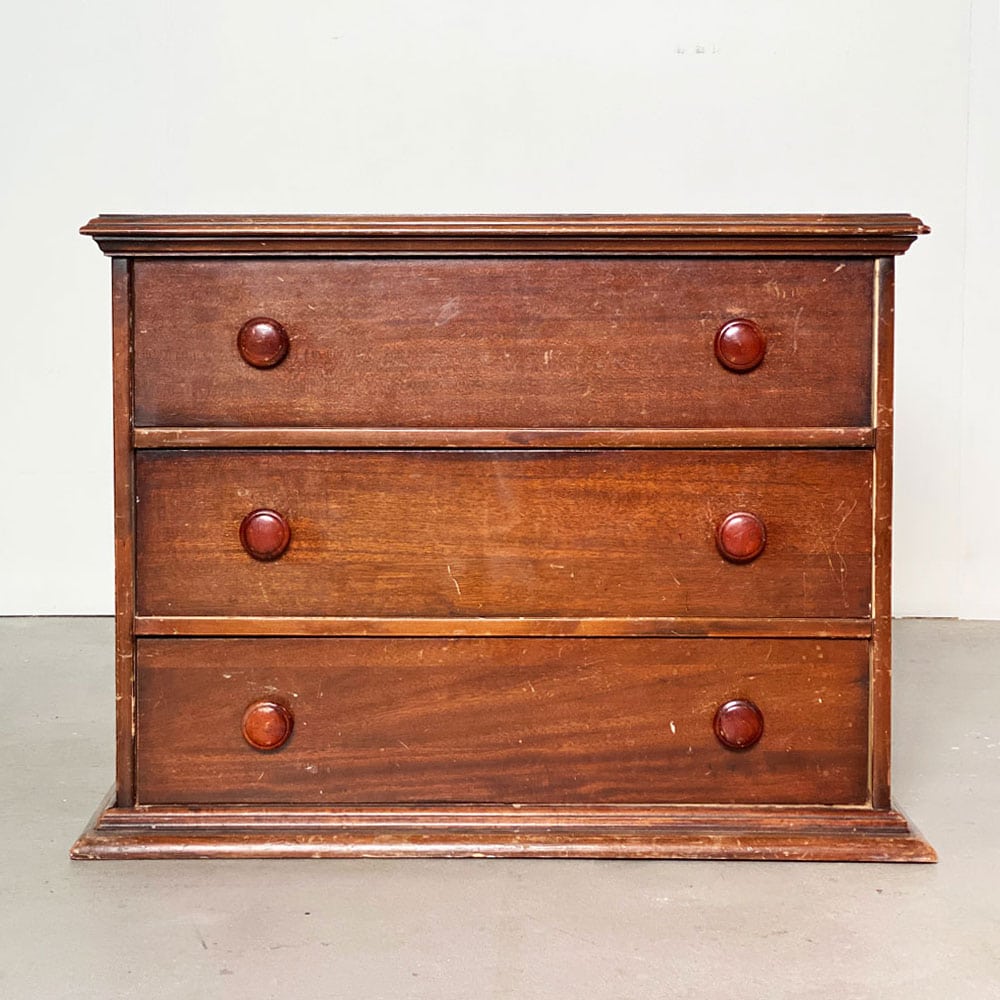
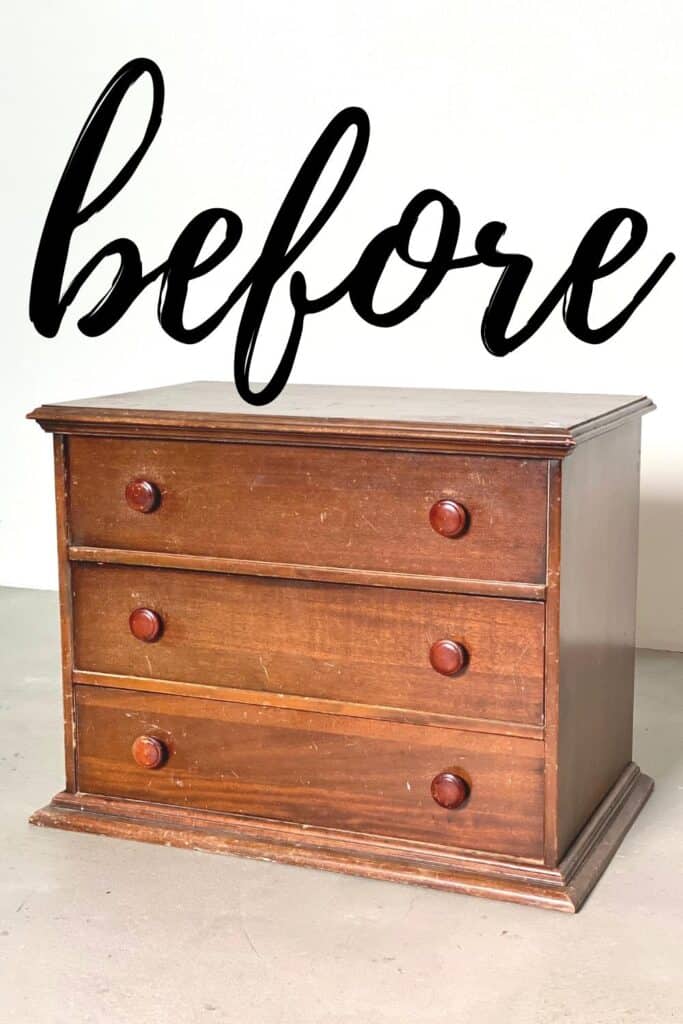
Stunning and so creative! I would keep it too!!!
I love the way you did the front. Not sure about the base, beautiful piece of furniture!!
It’s very pretty, but I personally would not want to have so many extra surfaces to catch dust! I like your shellac trick!
Have you tried brushing with Melange One Paint ?
Is it better than Benjamin Moore Advanced ?
I have. I think Benjamin Moore Advance levels a little bit better.
Oh I love it! Can it be shipped to Texas? Lolol